Hisense Electric LCDC0030 Part15 Subpart B-LED LCD TV User Manual W9HLCDC0030
Hisense Electric Co., Ltd. Part15 Subpart B-LED LCD TV W9HLCDC0030
W9HLCDC0030_User Manual

ES-G132207 Español
MANUAL DEL USUARIO
Antes de utilizar el televisor, por favor lea este manual
detenidamente y consérvelo para futuras referencias.
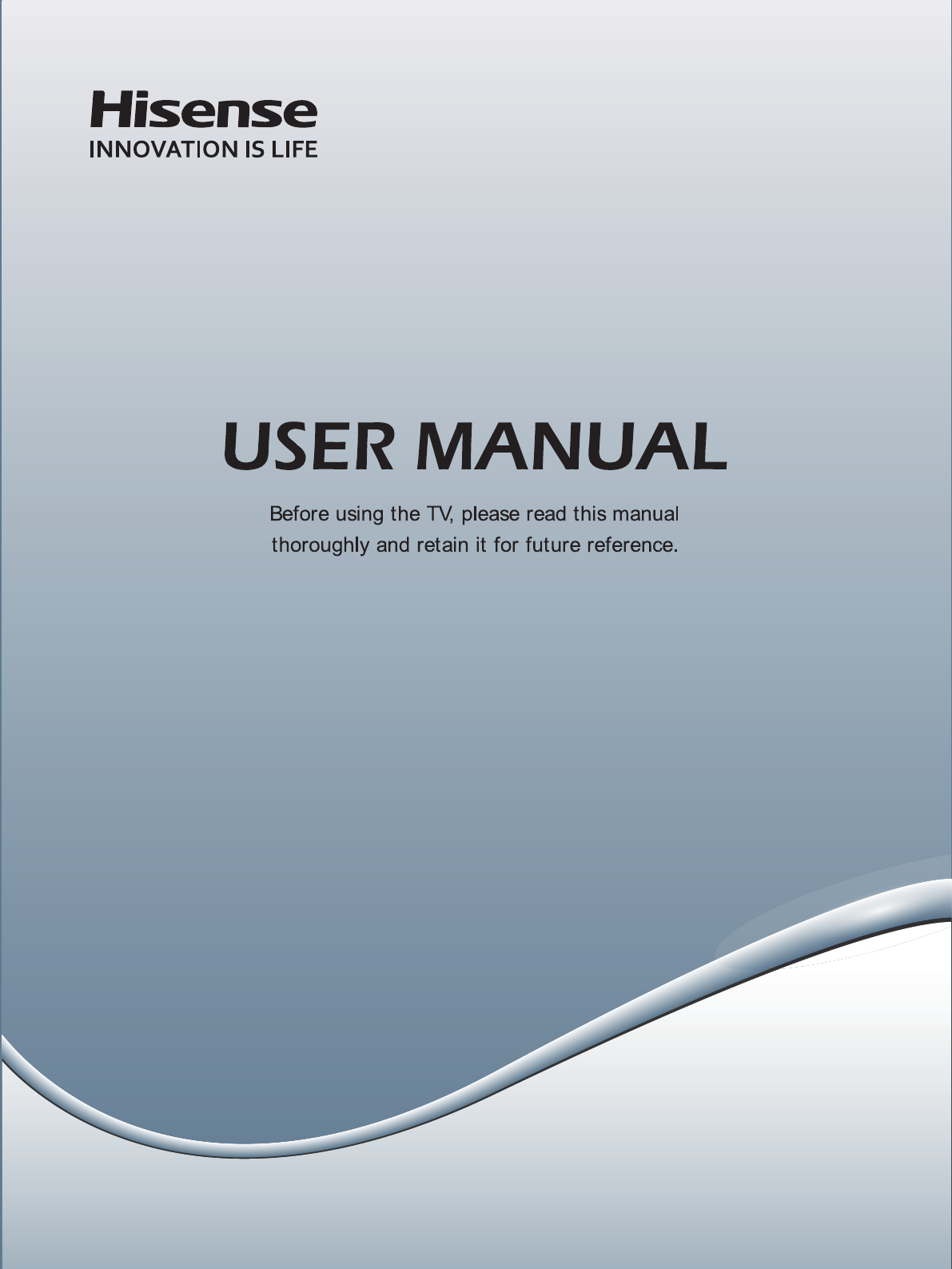
English
ES-G132207
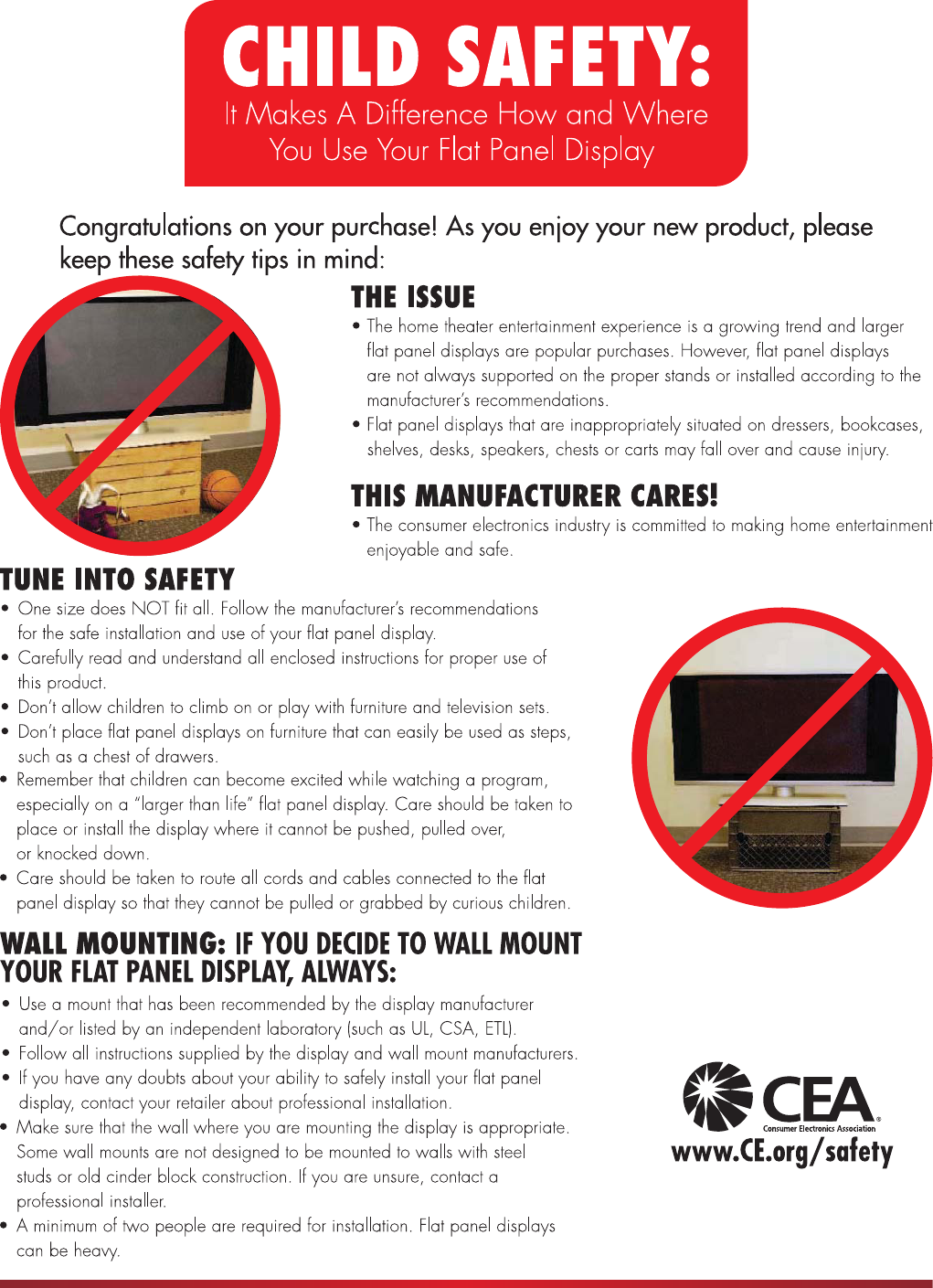
I
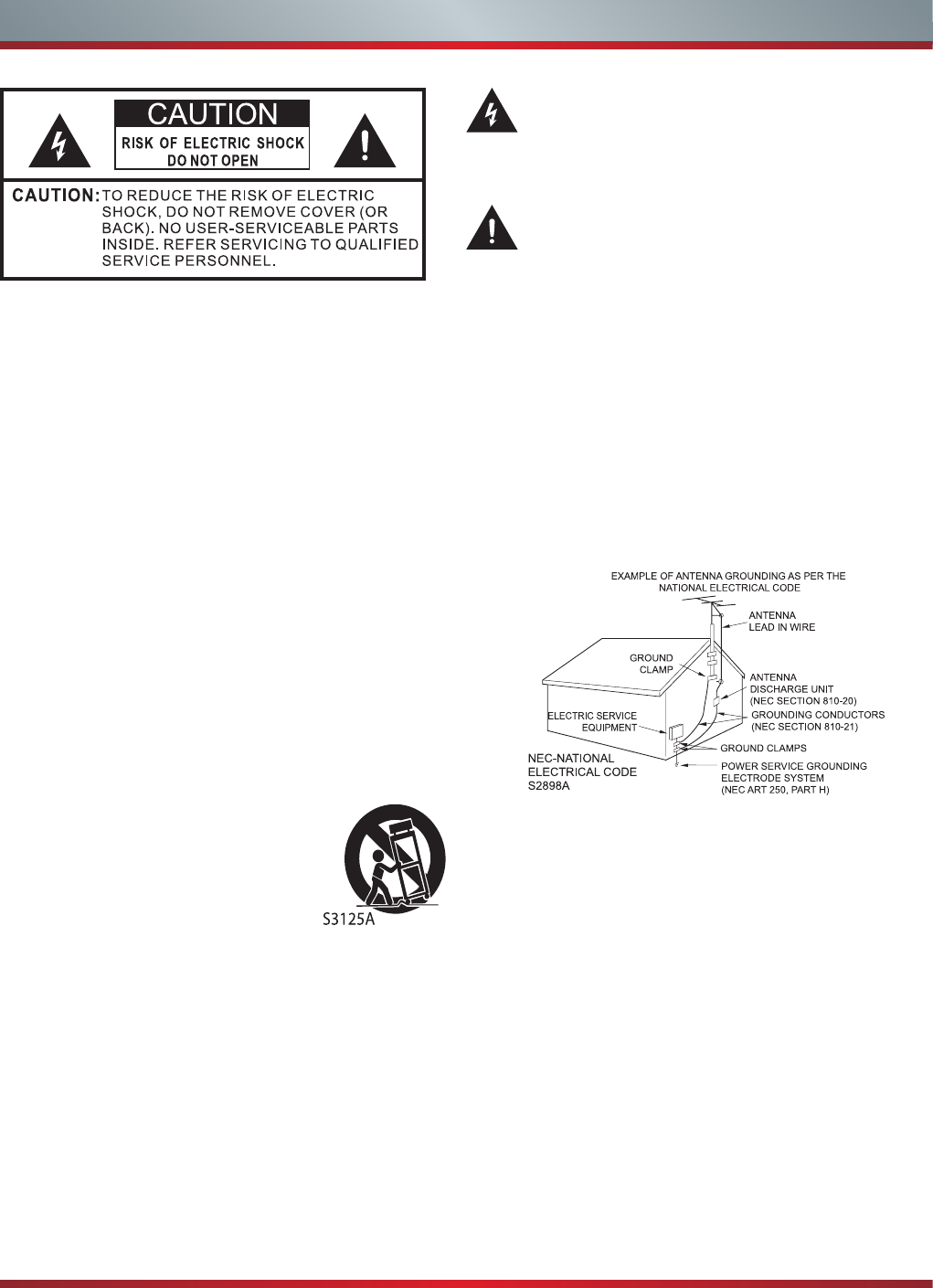
II
Important Safety Instructions
1. Read these instructions.
2. Keep these instructions.
3. Heed all warnings.
4. Follow all instructions.
5. Do not use this apparatus near water.
6. Clean only with dry cloth.
7. Do not block any ventilation openings. Install in accordance
with the manufacturer's instructions.
8. Do not install near any heat sources such as radiators,
heat registers, stoves, or other apparatus (including
amplifiers) that produce heat.
9. Do not defeat the safety purpose of the polarized or
grounding-type plug. A polarized plug has two blades with
one wider than the other. A grounding type plug has two
blades and a third grounding prong. The wide blade or the
third prong are provided for your safety. If the provided
plug does not fit into your outlet, consult an electrician for
replacement of the obsolete outlet.
10. Protect the power cord from being walked on or pinched
particularly at plugs, convenience receptacles, and the
point where they exit from the apparatus.
11. Only use attachments/accessories specified by the
manufacturer.
12. Use only with cart, stand, tripod,
bracket, or table specified by the
manufacturer, or sold with the
apparatus. When a cart is used,
use caution when moving the cart/
apparatus combination to avoid injury
from tip-over.
13. Unplug this apparatus during lightning storms or when
unused for long periods of time.
14. Refer all servicing to qualified service personnel.
Servicing is required when the apparatus has been
damaged in any way, such as power-supply cord or plug
is damaged, liquid has been spilled or objects have fallen
into the apparatus, the apparatus has been exposed to
rain or moisture, does not operate normally, or has been
dropped.
15. Apparatus should not be exposed to dripping or
splashing, and objects filled with liquids, such as vases,
should not be placed on the apparatus.
16. An outside antenna system should not be located in the
vicinity of overhead power lines or other electric light or
power circuits, or where it can fall into such power lines
or circuits. When installing an outside antenna system,
extreme care should be taken to keep from touching
such power lines or circuits, as contact with them might
be fatal.
17. Do not overload wall outlets and extension cords, as this
can result in a risk of fire or electric shock.
18. Do not push objects through any openings in this unit,
as they may touch dangerous voltage points or short out
parts that could result in fire or electric shock. Never spill
or spray any type of liquid into the unit.
19. If an outside antenna or cable system is connected to the
unit, be sure the antenna or cable system is grounded to
provide some protection against voltage surges and built-
up static charges, Section 810 of the National Electrical
Code, ANSI/NFPA 70, provides information with respect
to proper grounding of the mast and supporting structure,
grounding of the lead-in wire to an antenna discharge
unit, size of grounding conductors, location of antenna
discharge unit, connection to grounding electrodes, and
requirements for the grounding electrode.
20. When replacement parts are required, be sure the service
technician uses replacement parts specified by the
manufacturer or those that have the same characteristics
as the original part. Unauthorized substitutions may result
in fire, electric shock or other hazards.
21. Upon completion of any service or repairs to this unit,
ask the service technician to perform safety checks to
determine that the unit is in proper operating condition.
The lightning flash with arrowhead symbol, within an
equilateral triangle is intended to alert the user to the
presence of uninsulated dangerous voltage within the
product's enclosure that may be of sufcient magnitude
to constitute a risk of electric shock.
The exclamation point within an equilateral triangle is
intended to alert the user to the presence of important
operating and maintenance (servicing) instructions in
the literature accompanying the appliance.

III
Important Safety Instructions
Your TV also contains material that can be recycled and
reused. For disposal or recycling information, contact your
local authorities or the Electronic Industries Alliance at
www.eia.org to find a recycler in your area.
End of life directives
Power source
WARNING
Do not connect this unit to the power using any device
other than the supplied AC cord. This could cause fire,
electrical shock, or damage.
Do not use with a voltage other than the power voltage
specified. This could cause fire, electrical shock, or
damage.
TO USE AC POWER
1. The power cord is attached to the TV at the factory.
2. Connect the AC cord into an AC outlet.
CAUTION
When this unit is not used for a long time, (e.g., away on
a trip) in the interest of safety, be sure to unplug it from
the AC outlet.
Do not plug/unplug the AC cord when your hands are
wet. This may cause electrical shock.
The LCD panel contains almost 3 million thin film transistors,
which provide exceptionally sharp video quality. Occasionally,
a few non-active pixels may appear on the screen as a
fixed black (in the case of a dead pixel), blue, green, or red
point. These non-active pixels do not adversely affect the
performance of your TV, and are not considered defects.
Non-active pixels
22. When you connect the product to other equipment, turn
off the power and unplug all of the equipment from the
wall outlet. Failure to do so may cause an electric shock
and serious personal injury. Read the owner's manual of
the other equipment carefully and follow the instructions
when making any connections.
23. Sudden high volume sound may cause hearing or
speaker damage. When you use headphones, (if the unit
is equipped with a headphone jack) keep the volume at a
moderate level. If you use headphones continuously with
high volume sound, it may cause hearing damage.
CONDENSATION:
Moisture will form in the operating section of the unit if the
unit is brought from cool surroundings into a warm room or
if the temperature of the room rises suddenly. When this
happens, unit's performance will be impaired. To prevent
this, let the unit stand in its new surroundings for about an
hour before switching it on, or make sure that the room
temperature rises gradually.
Condensation may also form during the summer if the unit is
exposed to the breeze from an air conditioner. In such cases,
change the location of the unit.
HOW TO HANDLE THE LCD PANEL:
Do not press hard or jolt the LCD panel. It may cause the
LCD panel glass to break and injury may occur.
If the LCD panel is broken, make absolutely sure that you
do not touch the liquid in the panel. This may cause skin
inflammation.
If the liquid gets in your mouth, immediately gargle and
consult with your doctor. Also, if the liquid gets in your eyes
or touches your skin, consult with your doctor after rinsing
for at least 15 minutes or longer in clean water.
Possible Adverse Effects on LCD Panel:
If a fixed (non-moving) pattern remains on the LCD Panel
for long periods of time, the image can become permanently
engrained in the LCD Panel and cause subtle but permanent
ghost images. This type of damage is NOT COVERED BY
YOUR WARRANTY. Never leave your LCD Panel on for long
periods of time while it is displaying the following formats or
images:
Fixed Images, such as stock tickers, video game patterns,
TV station logos, and websites.
Special Formats that do not use the entire screen. For
example, viewing letterbox style (16:9) media on a normal
(4:3) display (black bars at top and bottom of screen); or
viewing normal style (4:3) media on a widescreen (16:9)
display (black bars on left and right sides of screen).
The following symptoms are not signs of malfunction
but technical limitation. Therefore we disclaim any
responsibility for these symptoms.
LCD Panels are manufactured using an extremely high
level of precision technology, however sometimes parts
of the screen may be missing picture elements or have
luminous spots.
This is not a sign of a malfunction.
Do not install the LCD Panel near electronic equipment that
produces electromagnetic waves. Some equipment placed
too near this unit may cause interference.
Effect on infrared devices - There may be interference
while using infrared devices such as infrared cordless
headphones.
Declaration of Conformity
This device complies with part 15 of the FCC Rules.
Operation is subject to the following two conditions:
(1) This device may not cause harmful interference and (2)
This device must accept any interference received, including
interference that may cause undesired operation.
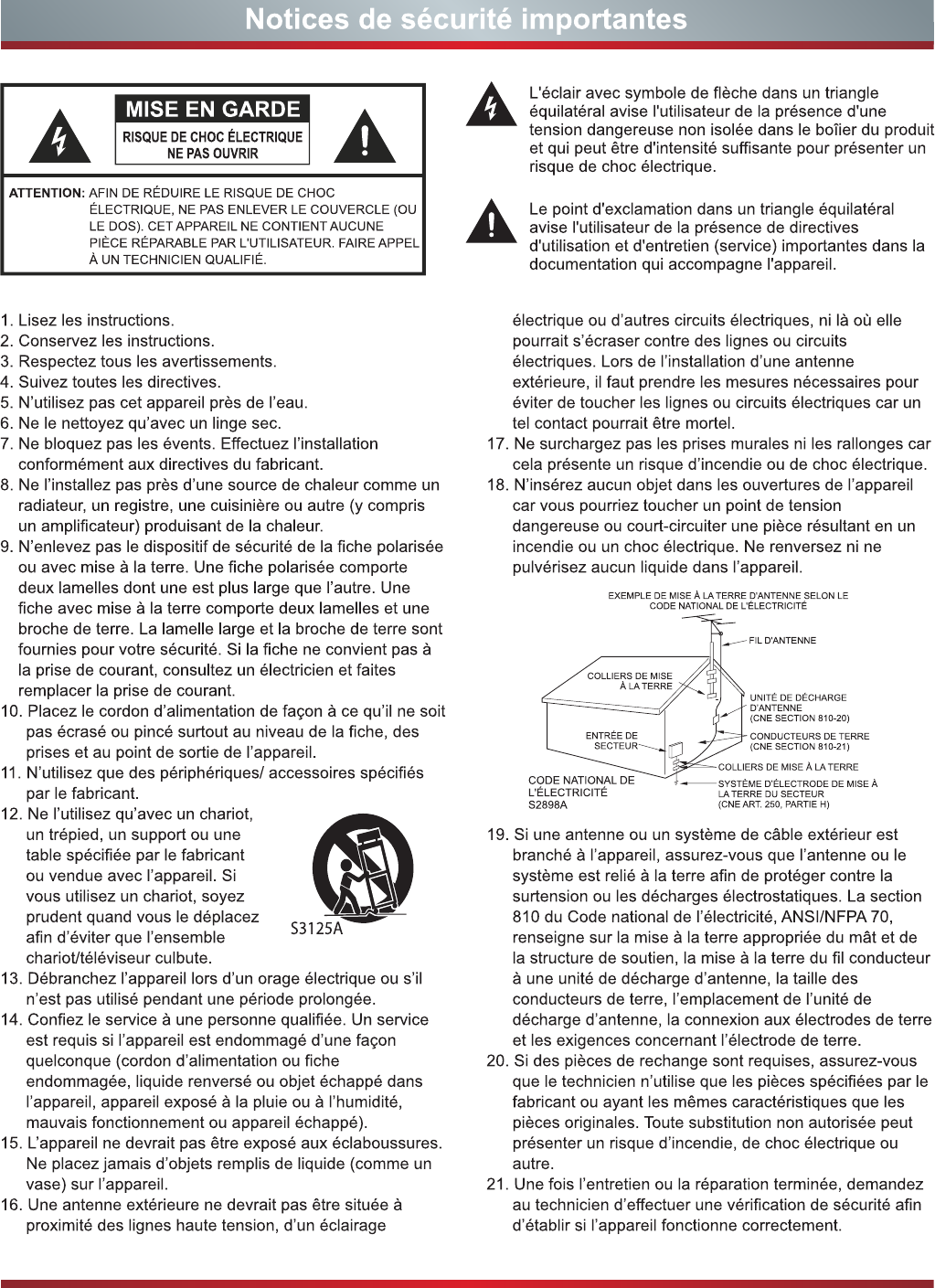
IV
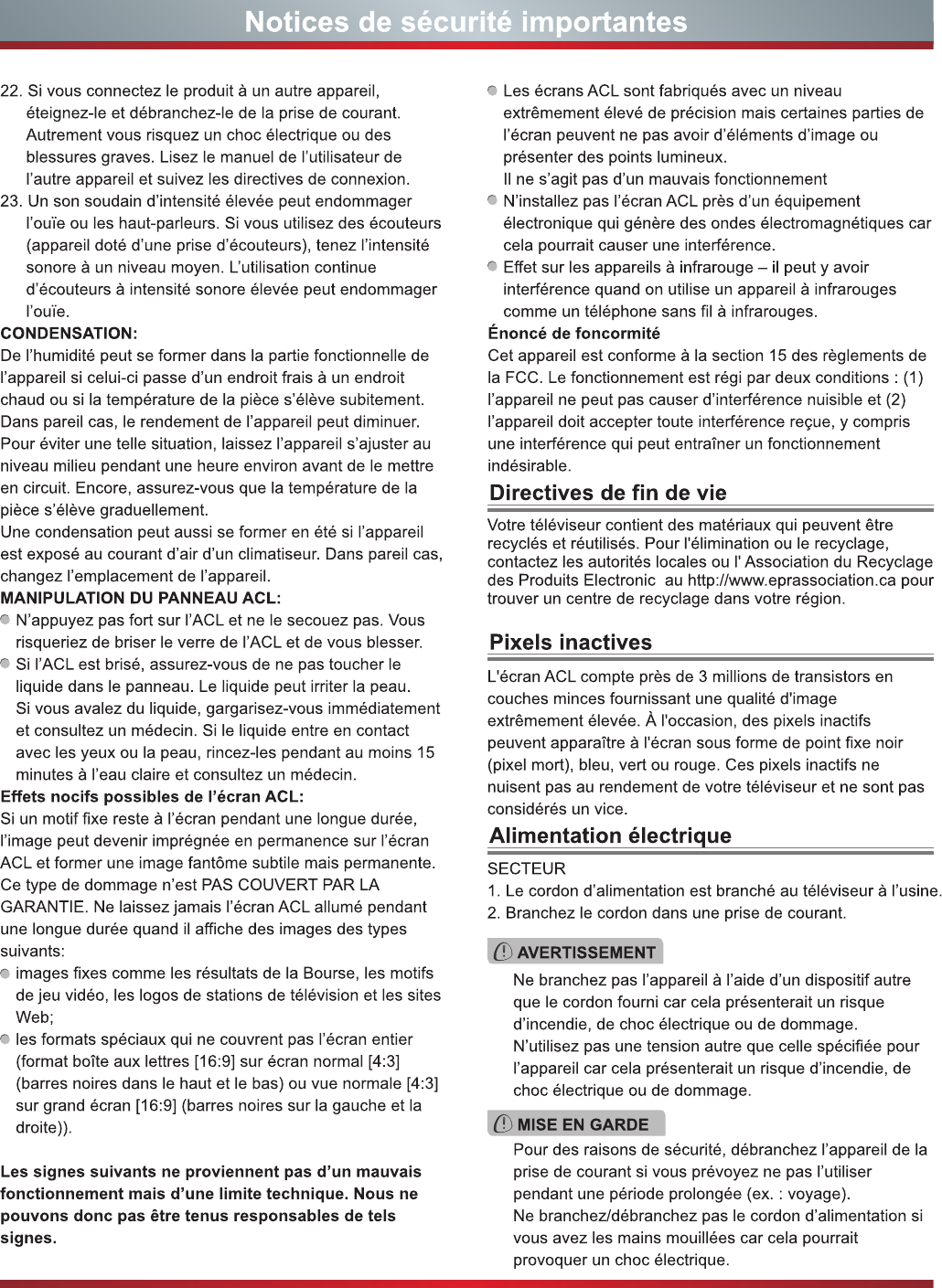
V
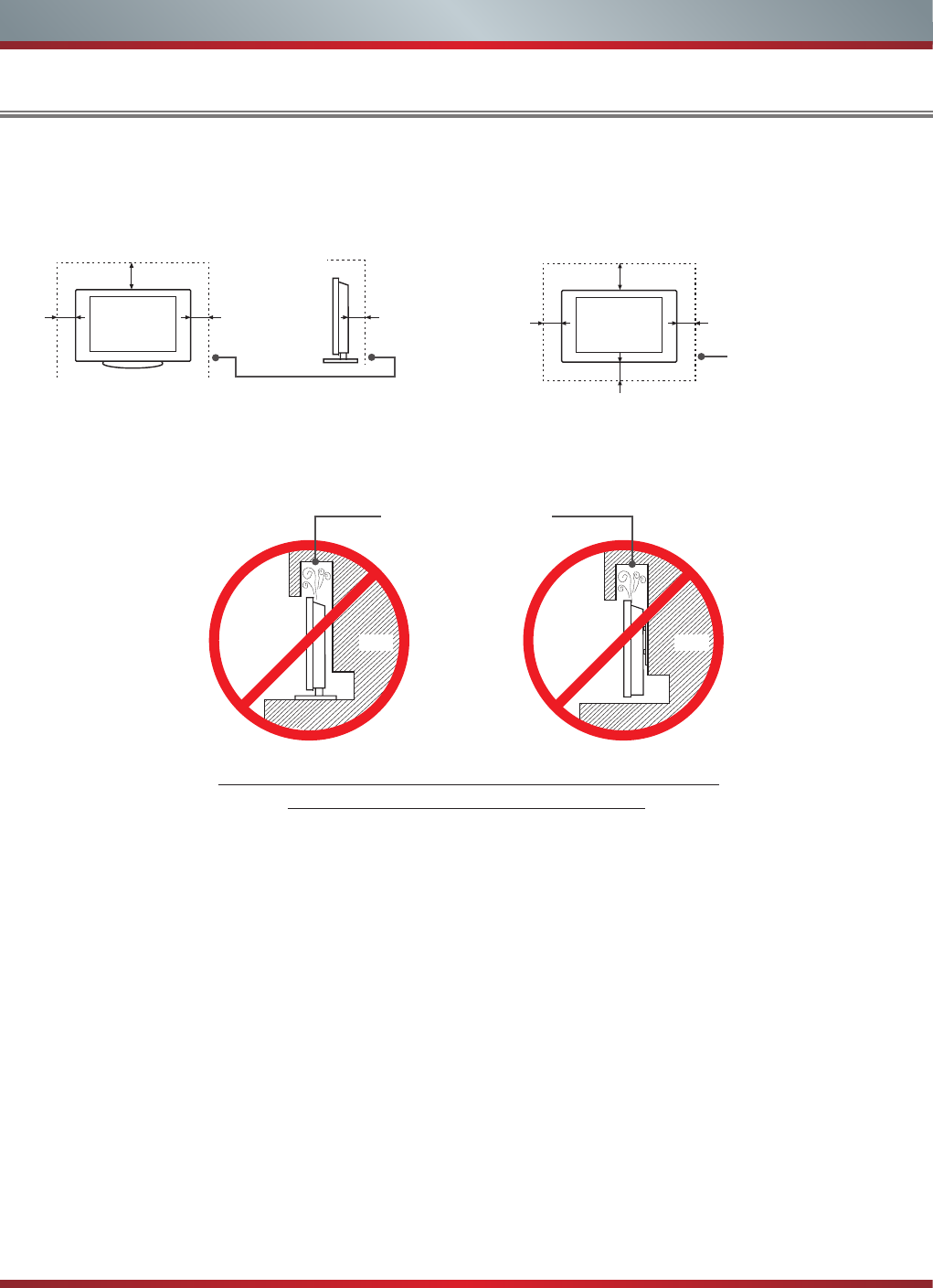
VI
Important Safety Instructions
When Installing the TV Against a Wall or Enclosed Area
Install with stand
Never install the TV set as follows:
Install on the wall
Make sure that your TV has adequate air circulation. Allow enough space around the TV as shown below. Avoid operating the
TV at temperatures below Inadequate air 41°F (5°C).
Leave at least this much
space around the set.
Leave at least this much
space around the set.
4 inches
(10cm)
4 inches
(10cm) 4 inches
(10cm)
4 inches
(10cm)
4 inches
(10cm)
2 3⁄8 inches
(6cm)
12 inches
(30cm) 12 inches
(30cm)
Wall Wall
Air circulation is blocked.
Inadequate air circulation can lead to overheating of the TV and
may cause damage to your TV or cause a re.
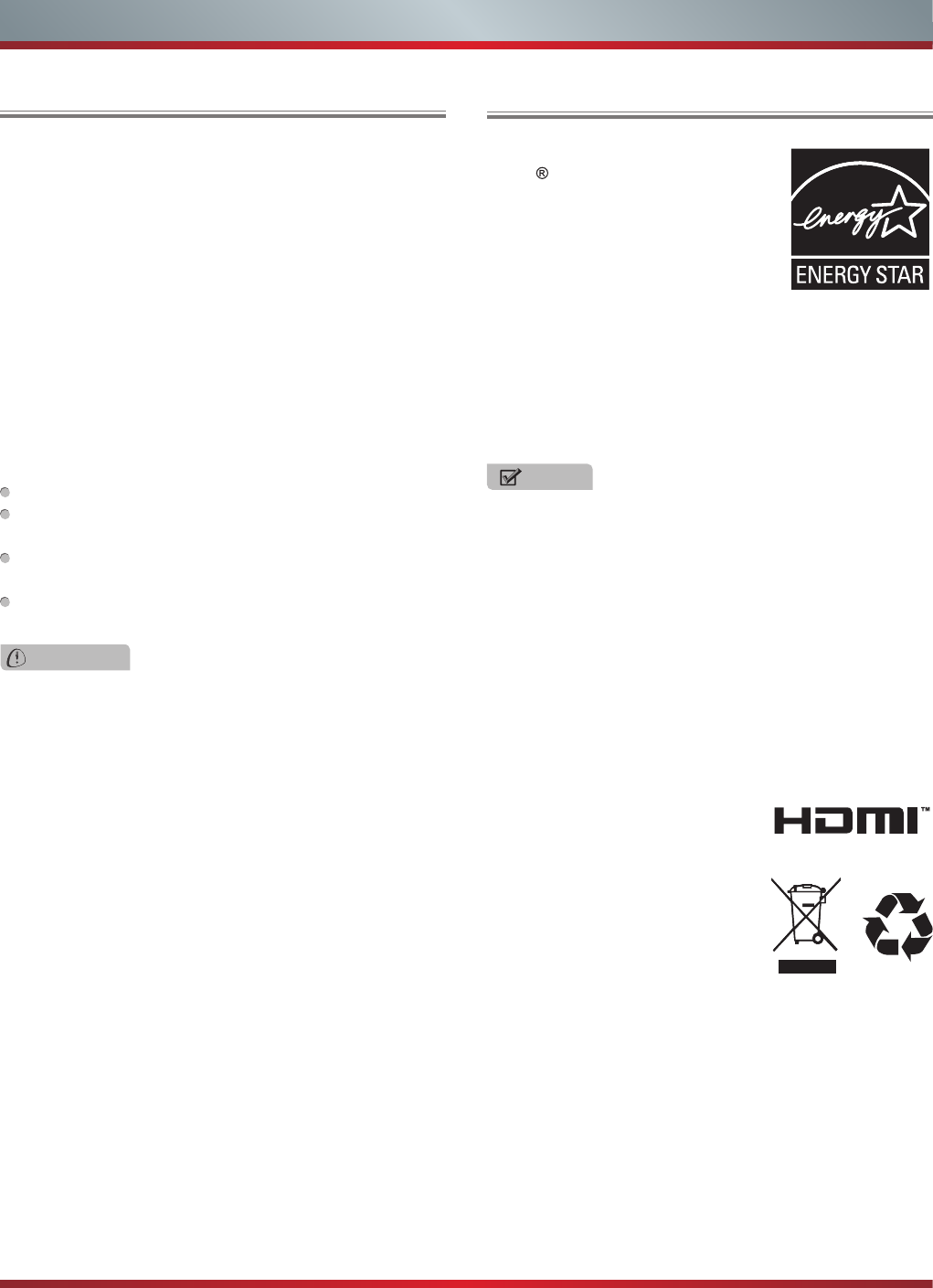
VII
Legal Notices
FCC Statement
NOTE:
This equipment has been tested and found to comply with
the limits for a class B digital Device, pursuant to part 15
of the FCC Rules. These limits are designed to provide
reasonable protection against harmful interference in a
residential installation. This equipment generates, uses and
can radiate radio frequency energy and, if not installed and
used in accordance with the instructions, may cause harmful
interference to radio Communications. However, there is
no guarantee that interference will not occur in a particular
installation. If this equipment does cause harmful interference
to radio or television reception, which can be determined by
turning the equipment off and on, the user is encouraged to
try to correct the interference by one or more of the following
measures:
Reorient or relocate the receiving antenna.
Increase the separation between the equipment and the
receiver.
Connect the equipment into an outlet on a circuit different
from that to which the receiver is connected.
Consult the dealer or an experienced radio/TV technician
for help.
WARNING
The manufacturer is not responsible for any radio or TV
interference caused by unauthorized modifications to
this equipment. Such modifications could void the user's
authority.
Hisense and associated logos where applicable are registered trademarks of Hisense Group in the United States and/or other
countries. All other trademarks are property of their respective owners. 2013 Hisense USA, Corporation. All Rights Reserved.
Manufactured under license from Dolby Laboratories. Dolby and the double-D symbol are trademarks of Dolby Laboratories.
* Specications subject to change without notice.
ENERGY STAR®
This television’s factory default settings as shipped meet ENERGY STAR requirements.
This TV has an Auto Shut Off feature that will automatically turn off the TV if there is no video signals detected within 15 minutes
Additionally this TV has LED backlighting which has greater energy saving benets versus conventional CCFL type TV.
This TV incorporates High-Denition Multimedia Interface (HDMITM) technology.
HDMI, the HDMI logo and High-Denition Multimedia Interface are trademarks or registered trademarks of HDMI Licensing LLC.
NOTE
Where the MAINS plug or an appliance coupler is used
as the disconnect device, the disconnect device shall
remain readily operable.
Energy Star
Your Hisense TV is ENERGY
STAR qualified in the “Energy
Savings” mode. It meets strict energy
efficiency guidelines set by the U.S.
Environmental Protection Agency
and Department of Energy. ENERGY
STAR is a joint program of these
government agencies, designed to
promote energy efficient products and practices. Changes to
certain features, settings, and functionalities of this TV (i.e.
TV Guide, Picture, Sound) can increase or change the power
consumption. Depending upon such changed settings, the
power consumption may exceed the limits required for the
ENERGY STAR qualification in the “Energy Savings” mode.

1
Contents
Getting Started
Viewing the Remote Control ............................................................................2
Installing Batteries in the Remote Control .......................................................3
Making Connections ........................................................................................ 4
Basic Features
Turning your TV on or off .................................................................................7
Turning the TV for the First Time ..................................................................... 7
Selecting the Input Source ..............................................................................8
Changing Channels / Volume .......................................................................... 8
Shortcuts Instructions ...................................................................................... 8
To Use the Menu ............................................................................................. 9
Using the Video Menu .....................................................................................9
Using the Audio Menu ....................................................................................10
Using the TV Menu ......................................................................................... 10
Using the Setup Menu .................................................................................... 11
Using the Parental Menu ................................................................................ 12
Using the Hotel Menu ..................................................................................... 13
Advanced Features
Digital Media Player........................................................................................15
Enjoy Video Files ............................................................................................ 15
Browse the Pictures........................................................................................15
Playable Format List .......................................................................................16
Other Information
Trouble Shooting ............................................................................................17
Specifications .................................................................................................19
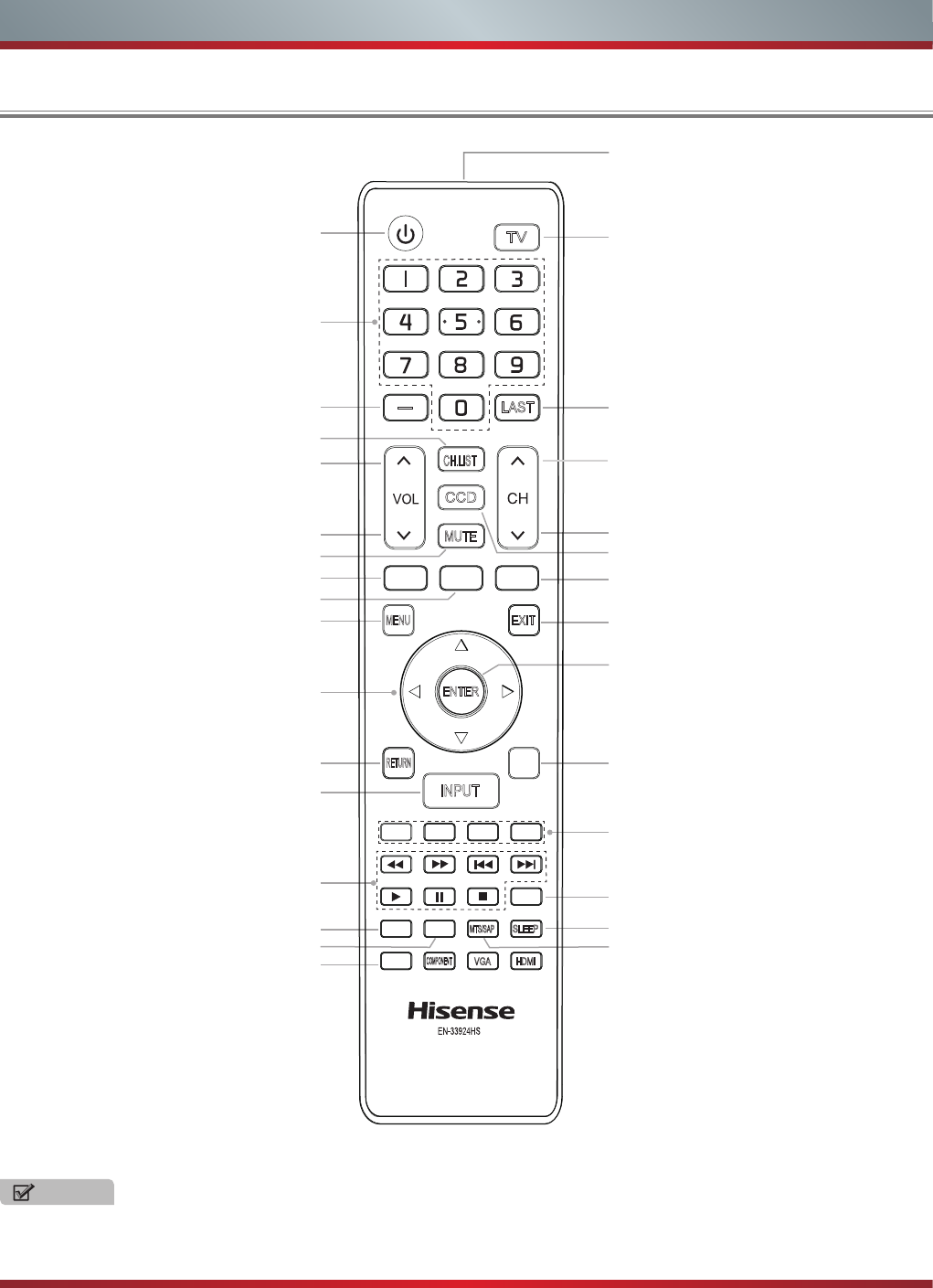
2
Viewing the Remote Control
Getting Started
NOTE
The Picture is Only for Reference.
Power on/off
▲/
▲
/
▲
/
▲
Move Up/Down/Left/Right
or adjust settings
Select input source
Remote sensor
Decrease volume
Select USB source
Select sound mode
Set the sleep timer
Media content control function buttons
Increase volume
Adjust closed caption mode
Display the current time
MENU button Close the menu
Dash button
Select a digital sub-channel Go to the previous channel
Media content control function buttons
Not available
Not available
Conrm selections
MUTE button
Zoom button
Display the information banner
Display the channel name
Next channel
Select picture mode
Previous channel
Select AV / VGA / COMPONENT / HDMI
source
Select TV source
Audio select button
Mono/Stereo/SAP operation
Direct channel selection
MMTTSS//SSAAPP
MUTE
EXIT
CCOOMMPPOONNEENNTT
HHDDMMII
RREETTUURRNN
DDIISSPPLLAAYY
MENU
SSLLEEEEPP
VVGGAA
--
TV
CH.LIST
LLAASSTT
CCD
SSOOUUNNDD
ENTER
PPIICCTTUURREE
INPUT
GUIDE
ASPECT
USB
TIME
AV
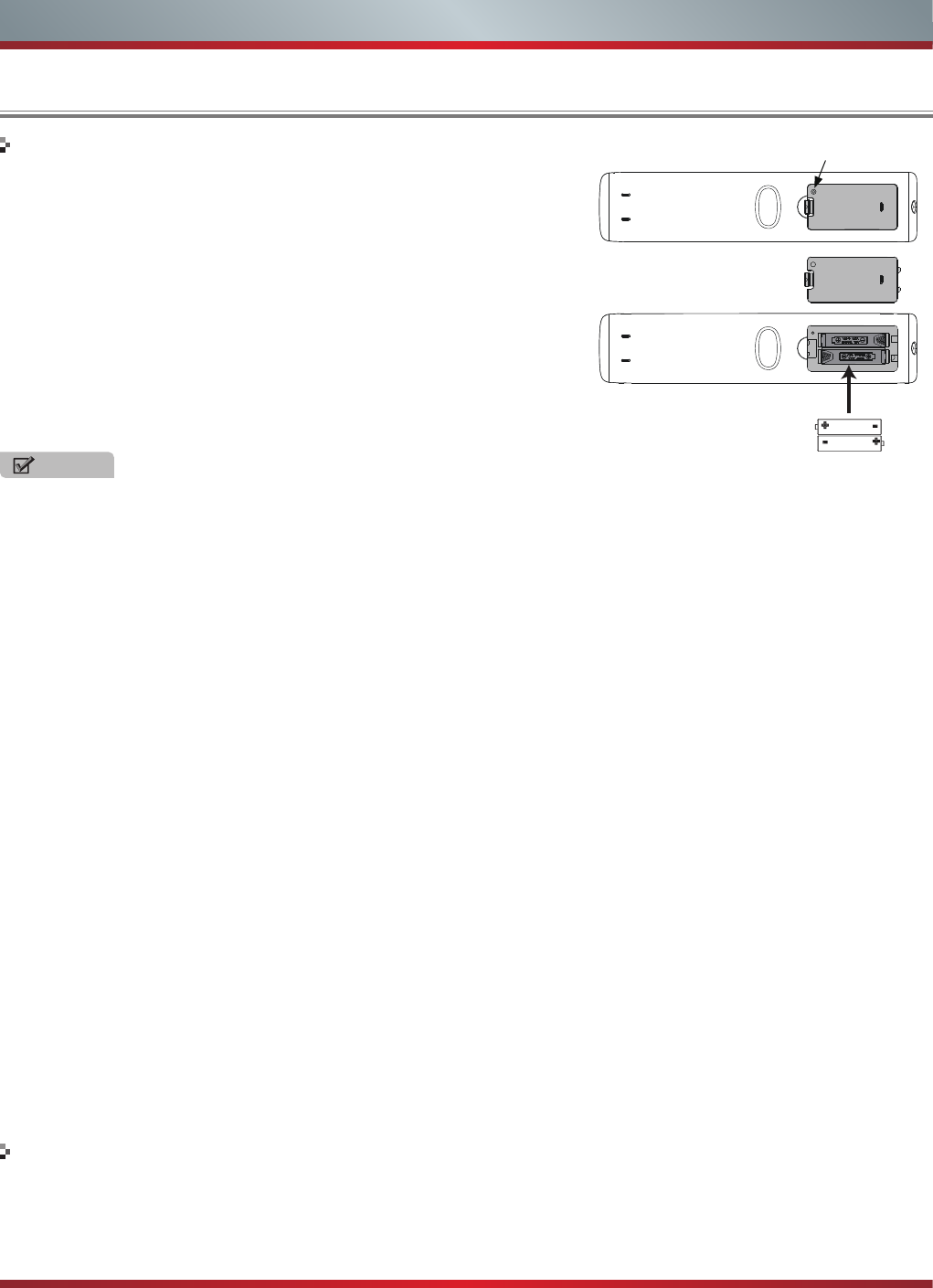
3
Installing Batteries in the Remote Control
Getting Started
1. Press the release button on the back of the remote control to remove the
battery compartment cover.
2. Insert two AAA size batteries. Make sure to match the (+) and ( - )
ends of the batteries with the (+) and ( - ) ends indicated in the battery
compartment.
3. Replace the battery compartment cover and secure with one screw
(ST2X6) provided.
1. The remote control distance: 315 inches in front of the TV set.
2. The remote control angle: taking the television infrared light receiver window as an apex, 236 inches away, its controlled
angle (left to right) is within 30 degrees, while the vertical angle (up to down) is within 30 degrees.
NOTES
1. Dispose of your batteries in a designated disposal area. Do not throw the batteries into a fire.
2. Do not mix battery types or combine used batteries with new ones.
3. Remove depleted batteries immediately to prevent battery acid from leaking into the battery compartment.
4. If you do not intend to use the remote control for a long time, remove the batteries.
5. Batteries should not be exposed to excessive heat, such as sunshine, heat registers, or fire.
6. Battery chemicals can cause a rash. If the batteries leak, clean the battery compartment with a cloth. If chemicals touch your
skin, wash immediately.
7. Do not mix old and new batteries.
8. Do not mix alkaline, standard (carbon-zinc) or rechargeable (ni-cad, ni-mh, etc.) batteries.
Program Your Universal Cable or Satellite Remote Control to Operate Your New Hisense Television!
If you would like to program your other household remote controls to your new Hisense television,please consult the User’s
Manual supplied by your Cable or Satellite provider. The Cable or Satellite providers’ User’s Manuals should include instructions
on how to program their remote to your television.
Below is a list of Hisense codes for the most common Cable and Satellite providers. Use the Hisense code that is associated
with your Cable or Satellite provider (if applicable).
DIRECTV……………………..…0178 or 10019
Time Warner Cable………….…386 or 0178
Comcast…………………………0178 or 10178
Cox Communications………..…0178
Dish Network……………………627 or 505
AT&T U-verse...........................1346
If the Hisense code associated with your Cable or Satellite provider is not listed above,if the code above does not work, or if
you cannot locate the instructions for programming your household remote to your television,call your local Cable or Satellite
provider’s customer service center.
Change the batteries
The effective range of remote control
screw (ST2X6)
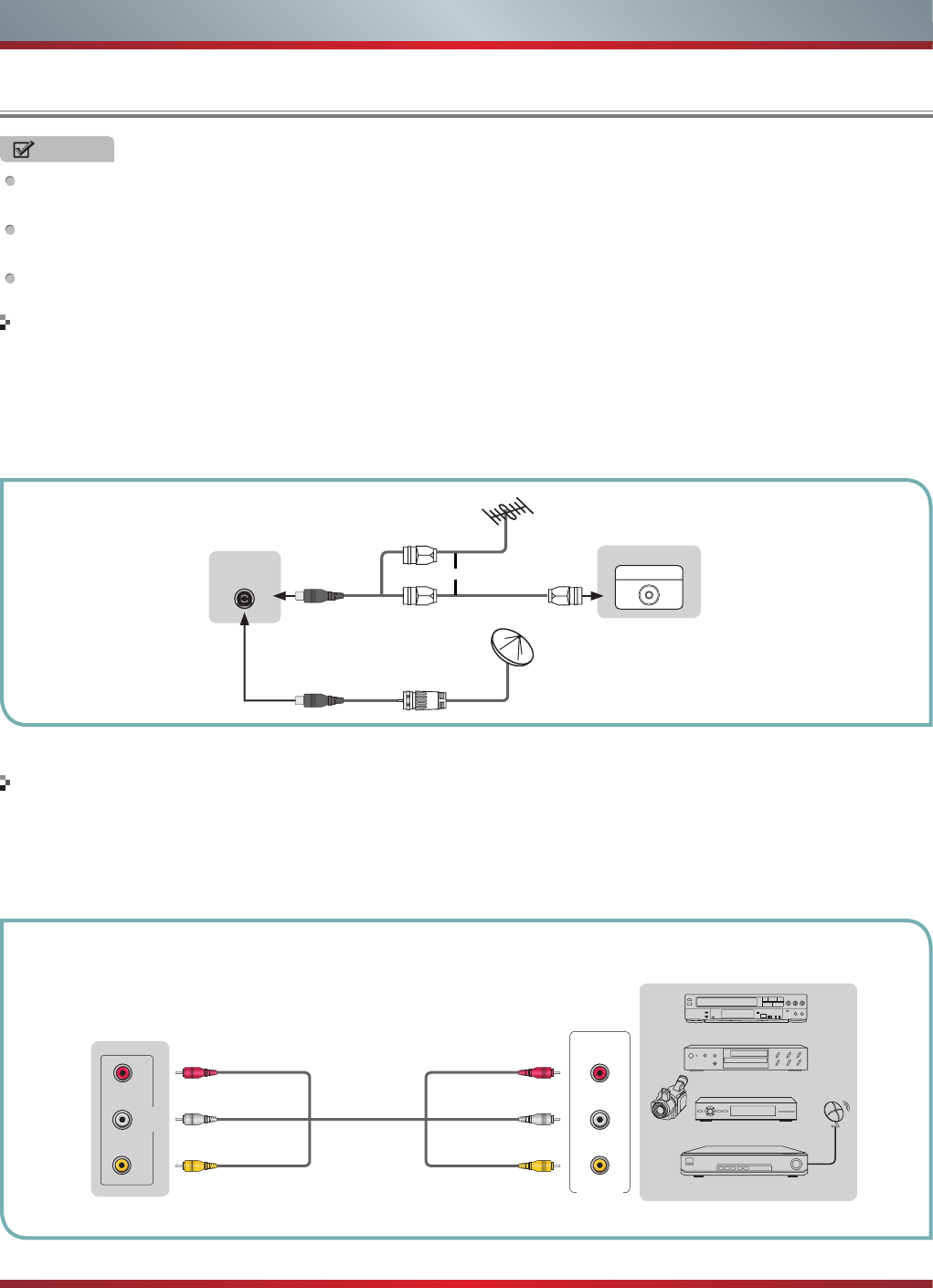
4
Making connections
Getting Started
NOTES
Check the jacks for position and type before making any connections. Loose connections can result in image or color
problems. Make sure that all connections are tight and secure.
Not all A/V devices have the ability to connect to a TV, please refer to the user manual of your A/V device for compatibility
and connections procedure.
Always unplug the power cord when connecting external equipment.
Connecting an antenna, cable or cable/satellite box
Connecting an A/V Device with Composite Cable
or ANT OUT
Cable
VHF/UHF Antenna
EXTERNAL DEVICESTV JACK
1. Turn off the TV before connecting the antenna.
2. Connect one end of a coaxial cable (not included) to the RF OUT jack on the antenna, cable or cable/satellite box. If you are
using an antenna with twin-lead cable, you may need a 300-75 ohm adapter (not provided) to connect it to the back of your
TV. Likewise, if you are using several antennas, you may need a combiner (not provided).
3. Connect the other end of the cable to the ANT/CABLE jack on the side of your TV.
1. Use the audio and video cables to connect the external A/V device’s composite video/audio jacks to the TV’s jacks. (Video =
yellow, Audio Left = white, and Audio Right = red)
2. Plug the connected devices into the mains socket before switching on the TV.
3. Select the corresponding source from the TV.
ANT/CABLE
Equipment with A/V jacks
DVD Player/Recorder
Video
Camera
EXTERNAL DEVICES
Set-top box
Satellite Receiver
Satellite
antenna
cable
VCR
A/V OUT
Video
L
R
White(L)White(L)
Yellow(Video)Yellow(Video)
Red(R)Red(R)
TV JACK
AV Cable
(not included)
VIDEO L R
AV IN
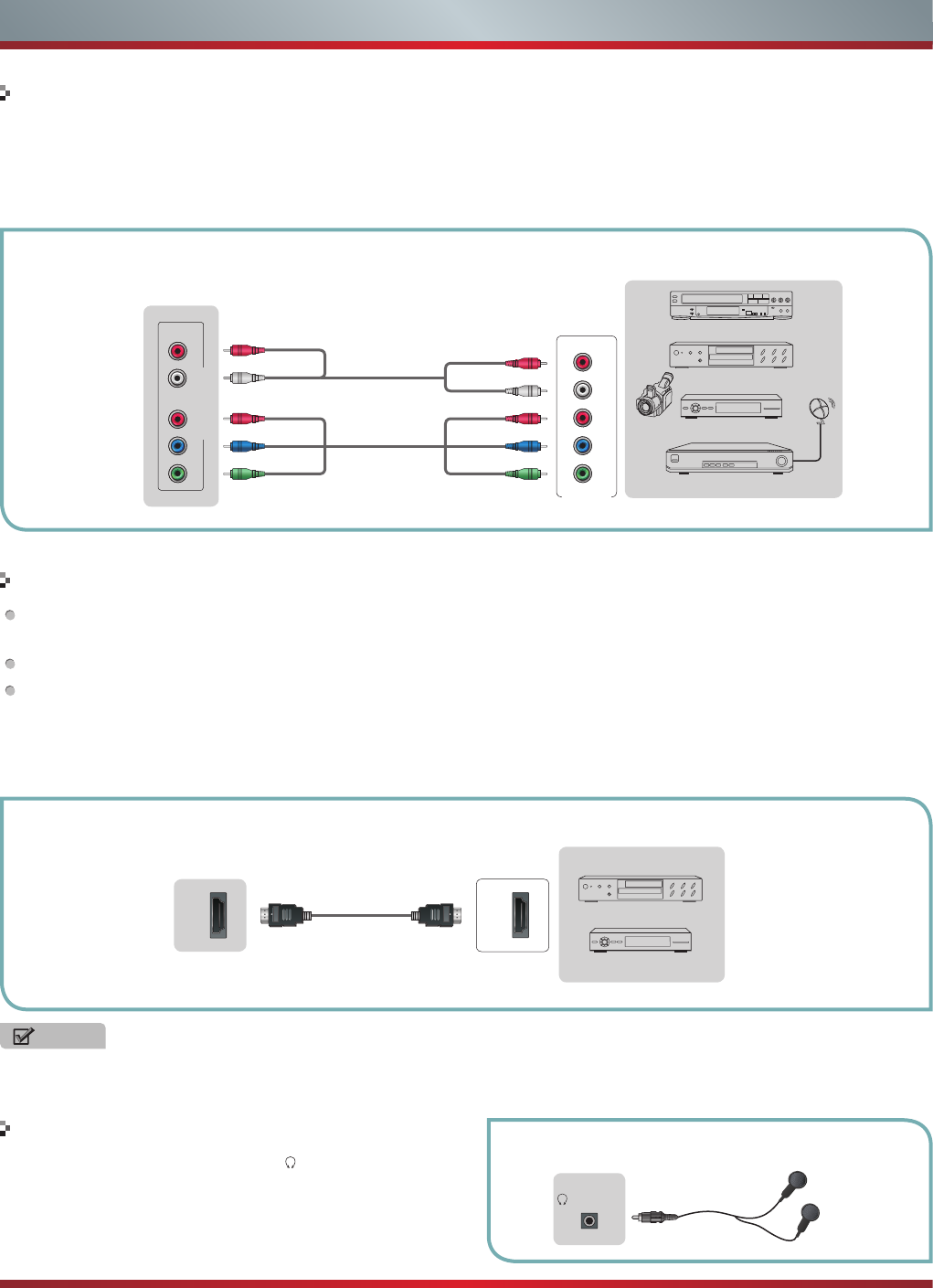
5
Getting Started
Connecting an A/V Device with Component (YPBPR) Cable
Connecting an A/V Device with HDMI Cable
Connecting a headphone
1. Use a component cable to connect the external A/V device’s component output jacks to the TV’s YPBPR jacks. Use an audio
cable to connect the external A/V device’s component audio jacks to the TV’s AUDIO (L/R) jacks.
2. Plug the connected devices into the mains socket before switching on the TV.
3. Select the corresponding source from the TV.
Support digital connections between HDMI - enabled A/V devices such as PVR, DVD, Blu-ray, AV receiver and digital
devices.
Some devices such as PVR or DVD player require HDMI signal to be set to output in the device's settings.
Please consult your device user manual for instructions.
1. Use an HDMI cable to connect the A/V device’s HDMI output jack to the TV’s HDMI jack.
2. Plug the connected devices into the mains socket before switching on the TV .
3. Select the corresponding source from the TV.
Headphones can be connected to the /AUDIO OUT output
on your set. (While the headphone is connected, the sound
from the built-in speakers will be disabled.)
NOTE
The HDMI connector provides both video and audio signals, it’s not necessary to connect the audio cable.
Y PBPR
COMPONENT IN
L R
Equipment with A/V jacks
DVD Player/Recorder
Video
Camera
EXTERNAL DEVICES
Set-top box
Satellite Receiver
Satellite
antenna
cable
VCR
White(L)
White(L)
Red(R)
Red(R)
Audio Cable
(not included)
Component Cable
(not included)
HDMI
HDMI
TV JACK
EXTERNAL DEVICES
DVD Player/Recorder
Set-top box
Equipment with HDMI jacks
HDMI Cable
(not included)
TV JACK
Component
R
L
PR
PB
Y
PR/CR
PR/CR
PB/CB
PB/CB
YY
AUDIO OUT
EXTERNAL DEVICESTV JACK
/AUDIO OUT
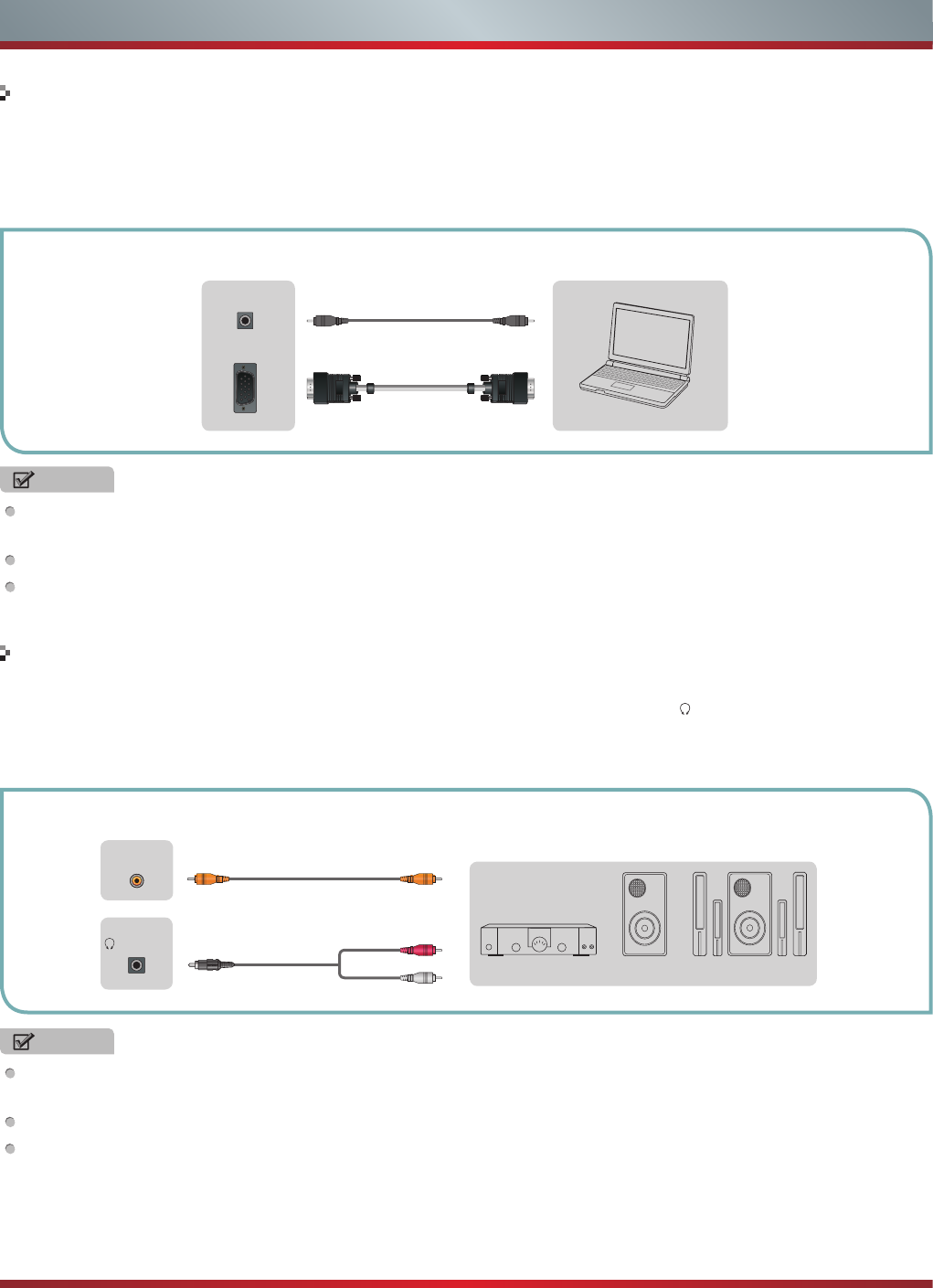
6
Getting Started
Connecting a PC with VGA Cable
1. Use a VGA cable to connect the PC’s VGA output jack to the TV’s VGA jack. Use an audio cable to connect the PC’s audio
output jack to TV’s PC/DVI AUDIO IN jack.
2. Plug the connected devices into the mains socket before switching on the TV.
3. Select the corresponding source from the TV.
NOTES
Primarily this unit is intended for use as an LCD TV. If you want to use it as a monitor, please contact the manufacturer of the
PC Video/Graphic's card for further support. Perfect compatibility is not warranted.
The VGA cable will not supplied with the product.
We strongly recommend to use VGA cable with 2 cores as shown in the figure.
EXTERNAL DEVICES
Computer
TV JACK
VGA PC/DVI AUDIO IN
Audio Cable
(not included)
VGA Cable
(not included)
Connecting an Audio Receiver with Audio cable
1. Use an audio cable to connect the A/V device’s digital audio in jack to the TV’s DIGITAL OUTPUT jack. Or use an RCA Y-cable
(1/8”-stereo mini to L/R phono - not provided) to connect analog sound system to the TV’s /AUDIO OUT jack.
2. Plug the connected devices into the mains socket before switching on the TV.
3. Select the corresponding source from the TV.
NOTES
When a digital audio system is connected to the DIGITAL OUTPUT (COAXIAL) jack, decrease the volume of both the TV
and the system.
5.1 CH (channel) audio is available when the TV is connected to an external device supporting 5.1 CH.
When the receiver (home theater) is set to on, you can hear sound output from the TV’s digital audio out jack. When the TV
is receiving a DTV signal, the TV will send 5.1 CH sound to the home theater receiver. When the source is connected to the
TV via HDMI, only 2 CH audio will be heard from the home theater receiver. If you want to hear 5.1 CH audio, connect the
digital audio out jack from your DVD/Blu-ray player/cable box/STB satellite receiver directly to an amplifier or home theater.
TV JACKS
EXTERNAL DEVICES
Powerless
Bass Speaker
Speaker
Audio Amplier
DIGITAL
OUTPUT
White(L)
Red(R)
Audio Cable
(not included)
Audio Cable
(not included)
/AUDIO OUT
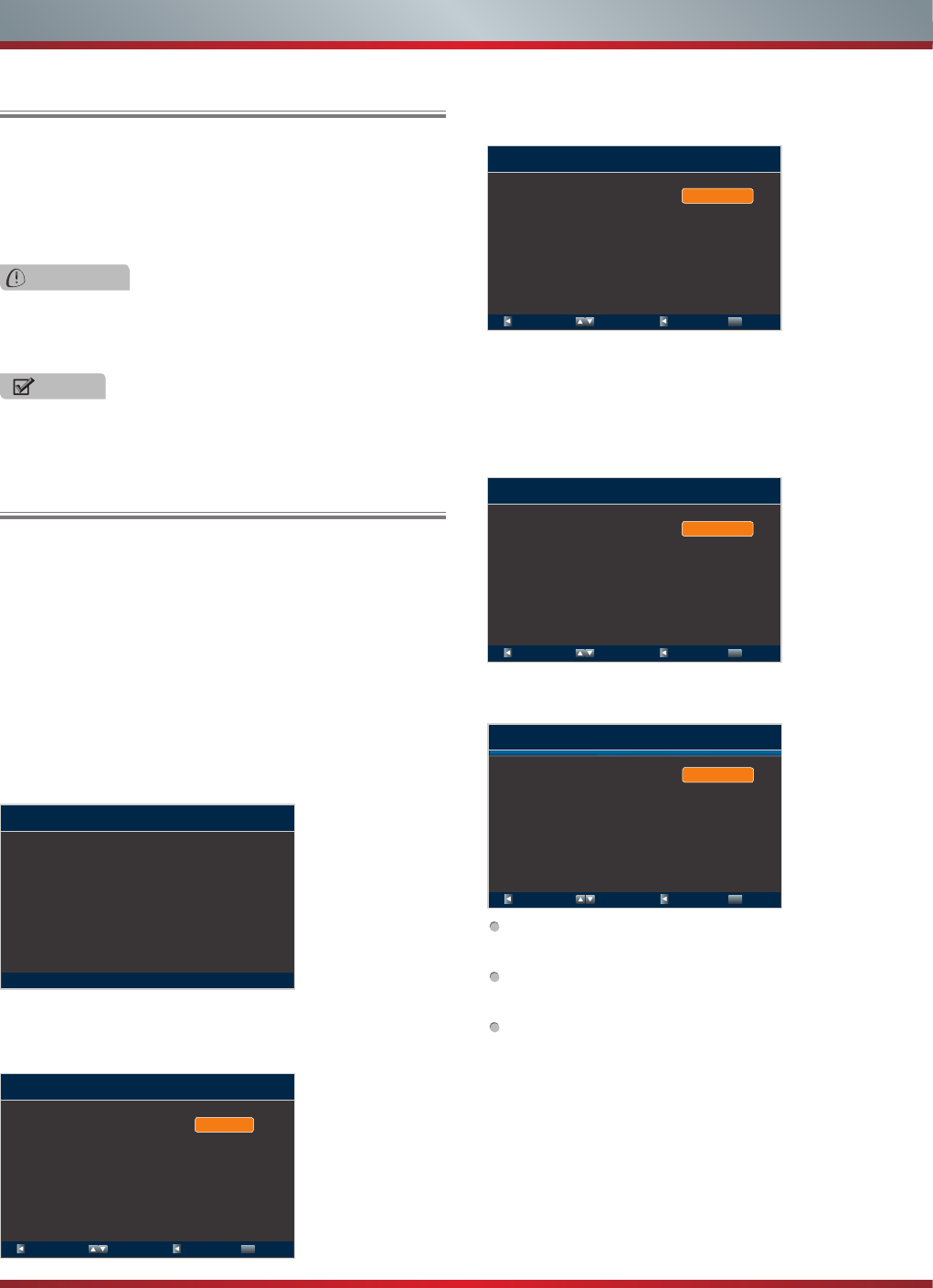
7
Basic Features
To turn your TV on or off (standby mode):
1. Plug the power cord into an AC power outlet.
2. Press [POWER] button. Your TV turns on.
3. Press [POWER] button again to turn off your TV. When
you turn off your TV, it goes into standby mode.
Turning your TV on or off
Turning the TV On for the First Time
WARNING
When your TV is in standby mode, it is still receiving
power. To completely disconnect power, unplug the power
cord.
NOTE
If your TV does not receive an input signal for several
minutes, it automatically goes into standby mode.
The Setup Wizard menu appears the first time you turn
on the TV. It will assist you to specify the menu language,
Picture Mode, Tuner Mode and Channel Installation.
IMPORTANT: Make sure that the antenna or cable is
connected.
1. Make sure that you have:
Installed the remote control batteries.
Connected an antenna or cable.
Connected the power cord.
2. Connect your TV’s power cord to a power outlet, then
press power. The Initial Setup screen opens.
3. Please press [ENTER] to start the wizard, then press
[▲/
▲
] button to select your language, press [ENTER]
button to confirm.
4. Press [▲/▼] to select your Picture Mode: Home Mode or
Retail Mode, press [ENTER] button to confirm.
If you select Retail Mode, a message appears “If you
select Retail Mode, then Energy saving is not realized.
Are you sure?” Select “Yes” to continue, or select “No” to
change your selection.
5. Press [▲/▼] to select your Tuner Mode: Antenna or
Cable, press [ENTER] button to confirm.
6. Press [▲/▼] to set the Channel Installation: Scan or Skip
Scan, press [ENTER] button to confirm.
If you select “Scan”, your TV automatically starts Channel
Installation available in your viewing area.
If you select “Skip Scan”, your TV does not scan for
channels.
Depending on the reception condition, it may take several
minutes to scan channels. Please allow the process to
complete without interruption.
Initial Setup Welcome
Welcome to use the Wizard for
Initial Setup!!
Please press [ ENTER ] to start the
wizard.
Initial Setup Language
Please select your language:
Back Select Next EXIT Exit
English
Español
Français
Initial Setup Picture Mode
Choose Your Picture Mode:
Home mode default settings are
recommended for in-home use.
ENERGY STAR® qualied.
Retail mode is intended for in-store
display and resets video settings at
Power On.
Home Mode
Retail Mode
Back Select Next EXIT Exit
Initial Setup Tuner
Please select your tuner mode: Antenna
Cable
Back Select Next EXIT Exit
Initial Setup Channel Scan
First, please connect cable and/or
antenna.
Start channel scan now?
If you skip this step, the channel
scan could be performed in Menu.
Scan
Skip Scan
Back Select Next EXIT Exit
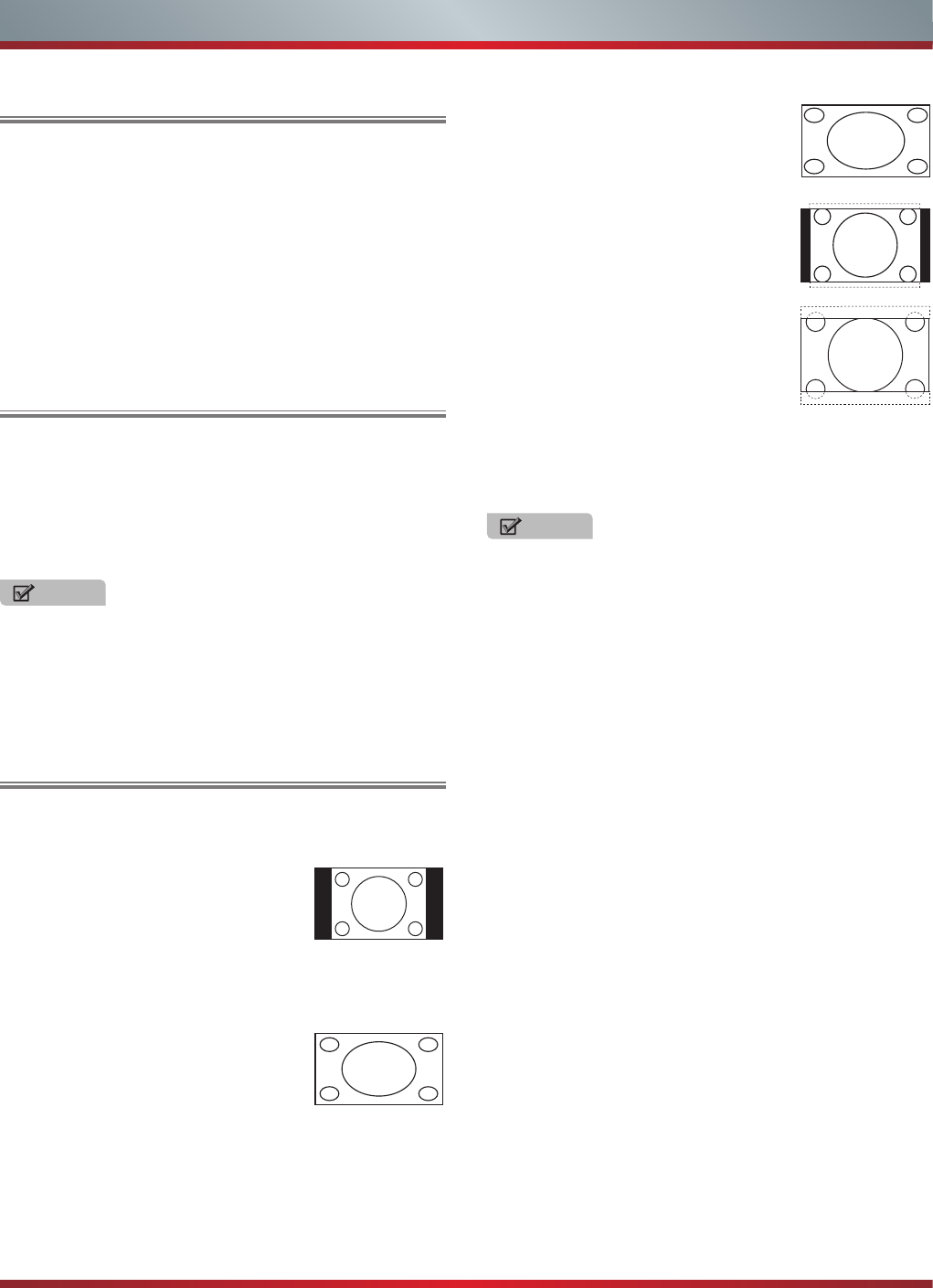
8
Basic Features
1. Press the [CH
V
/V] (or [CH +/-]) on the TV/remote control
to change the channel.
2. Press the [VOL
V
/V] (or [VOL +/-]) on the TV/remote
control to adjust the volume.
3. Press the numeric buttons on the remote control to
display the corresponding channels.
Changing Channels / Volume
The first time you turn on your TV, you must select the TV
signal source. Your TV stores this information, so you do not
need to change the TV signal source unless it changes. For
example, you change from an outside antenna to cable TV.
To select the video input source:
1. Turn on your TV, then press [INPUT] button on the remote
or on the TV. The Input Source menu opens.
2. Press [▲/
▲
] button to highlight the input source, then
press [ENTER] button.
Selecting the Input Source
NOTE
Changing the channels can also be achieved by directly
entering the channel number using the numeric keys on
the remote control. If you are entering a two or three digit
channel number, the time between key presses should be
less than 3 seconds.
Aspect - Select the screen aspect ratio from Auto, Normal,
Wide, Zoom and Cinema.
Normal: The original 4:3 aspect
ratio (1.33:1 signal) is preserved,
so black bars are added to the left
and right of the image. Standard TV
broadcasts are displayed with a 4:3
aspect ratio.
Wide: When watching a standard
broadcast or full-frame movie in
this mode, the display image is
stretched proportionately to fill
the TV screen. When watching a
widescreen (1.78:1 signal) program
or movie, the display image fills the
TV screen.
Shortcuts Instructions
Auto: Automatically adjusts the
image based on the screen size and
the TV program.
Zoom: Stretch the 4:3 aspect ratio
image vertically and horizontally to
fill the screen at 1:1.78 aspect ratio.
Cinema: Stretch the 4:3 aspect ratio
image vertically and horizontally to
fill the screen at 1:2.35 aspect ratio.
Picture - Press to set the picture mode. It can be set as
Vivid, Standard, Energy Savings, Game, Theater or Custom.
This mode achieves a certain image display effect by setting
the brightness, contrast and color etc.
Sound - Press to set the sound mode. It can be set as
Standard, Theater, News, Music and Custom.
Mute - Press to turn the sound off, press this button again
to turn the sound back on. This function is used to switch off
sound temporarily.
Sleep - It can set the TV to let it enter into the Standby
state automatically. Press this button repeatedly to select
the proper sleeping clock mode, and the clock tells you the
remaining time before the TV enters Standby state.
Display - Display the information banner. The information
including channel number, channel name, current system
time, tuner mode, audio stream, video format, audio
language, closed caption mode, parental locks rated,
program details, etc.
NOTE
The Game mode is not available in ATV and USB source.
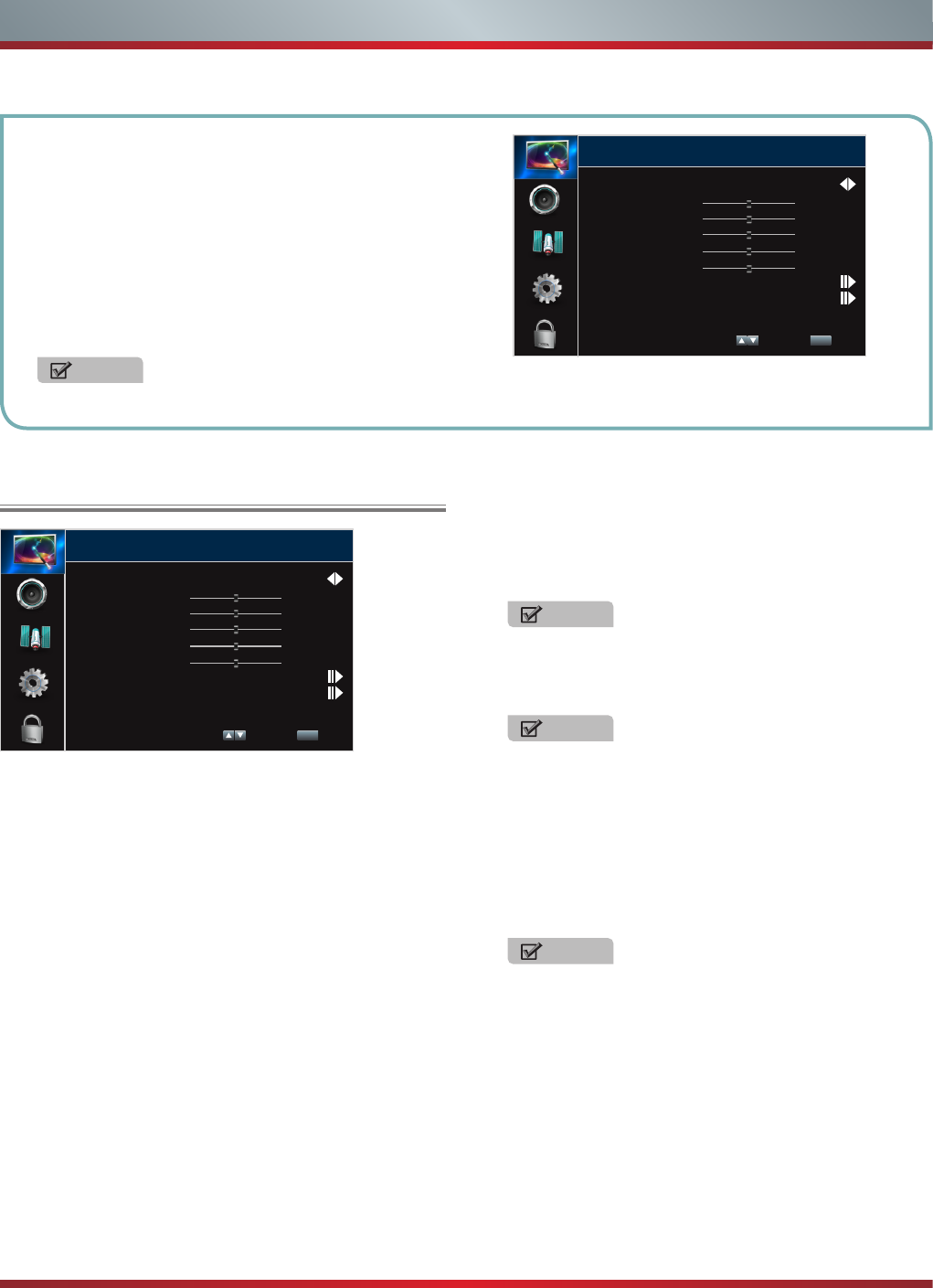
9
Using the Video Menu
You can adjust:
Picture Mode - Adjust the Picture Mode. You can select
Vivid, Standard, Energy Saving, game, Theater or Custom.
Brightness - Increase or decrease the brightness of the
picture. Increasing the brightness can add more light to dark
areas of the picture, while decreasing the brightness can
add more darkness to light areas of the picture.
Contrast - Increase or decrease the contrast of the picture.
Increase the contrast to adjust the white areas of the picture
or decrease the contrast to adjust the black areas of the
picture.
Saturation - Adjust the intensity of the colors.
HUE - Adjust the overall color of the picture.
Sharpness - You can increase the sharpness level for clearer
images or decrease the sharpness level for smoother images.
Advanced Video - Access advanced video settings such as
Back Light, Color Temperature and DNR.
Basic Features
To Use the Menu
1Press the [MENU] to open the main menu.
2Press [▲/
▲
] to select a menu option, then press [
▲
/
ENTER] button to enter the menu.
3In each menu, you can:
Press [▲/
▲
] to select an item,
Press [
▲
/
▲
] to adjust the value, or
Press [
▲
/ENTER] to enter the submenu,
Press [MENU] to back the previous menu.
4Press [EXIT] to exit the menu.
NOTE
The menus in the user manual may vary slightly from the actual screen.
Picture Mode Standard
Brightness
Contrast
Saturation
HUE
Sharpness
Advanced Video
Reset Video Settings
The TV qualies for ENERGY STAR in Energy
Saving mode.
50
50
50
0
10
Select MENU Back
Video
Back Light: Sets the overall brilliance of the screen.
When the option of Adaptive Back Light sets Low or High,
you cannot change the Back Light setting.
120HZ Smooth Effect: Inserts frames to reduce judder
in fast action scenes. You can select On or Off.
Aspect Ratio: To choose the screen aspect ration from
Wide, Auto, Normal, Zoom and Cinema.
Color Temperature: Change the color temperature. You
can select the color temperature from three options: Cool,
Standard or Warm.
Overscan: Adjusts the picture’s reproduction rate. You
can select On or Off.
DNR: Select to reduce the noise level of connected
equipment: off, Low, Medium, Strong, Auto.
Adaptive Luma Control: According to the content of
picture, it can adjust brightness automatically.
Adaptive Back Light: Enhances the contrast ratio
between light and dark areas of the picture. You can
select Off, Low, or High.
Reset Video Settings - Resets all Video Settings to the
factory defaults.
NOTE
The option of the screen Aspect Ration is different in
different inputs. (For more information, see “Shortcuts
Instructions”)
NOTE
Only available in DTV, HDMI (Except Game mode)
and Component source.
NOTE
Only Model 50” has this function.
Picture Mode Standard
Brightness
Contrast
Saturation
HUE
Sharpness
Advanced Video
Reset Video Settings
The TV qualies for ENERGY STAR in Energy
Saving mode.
50
50
50
0
10
Select MENU Back
Video
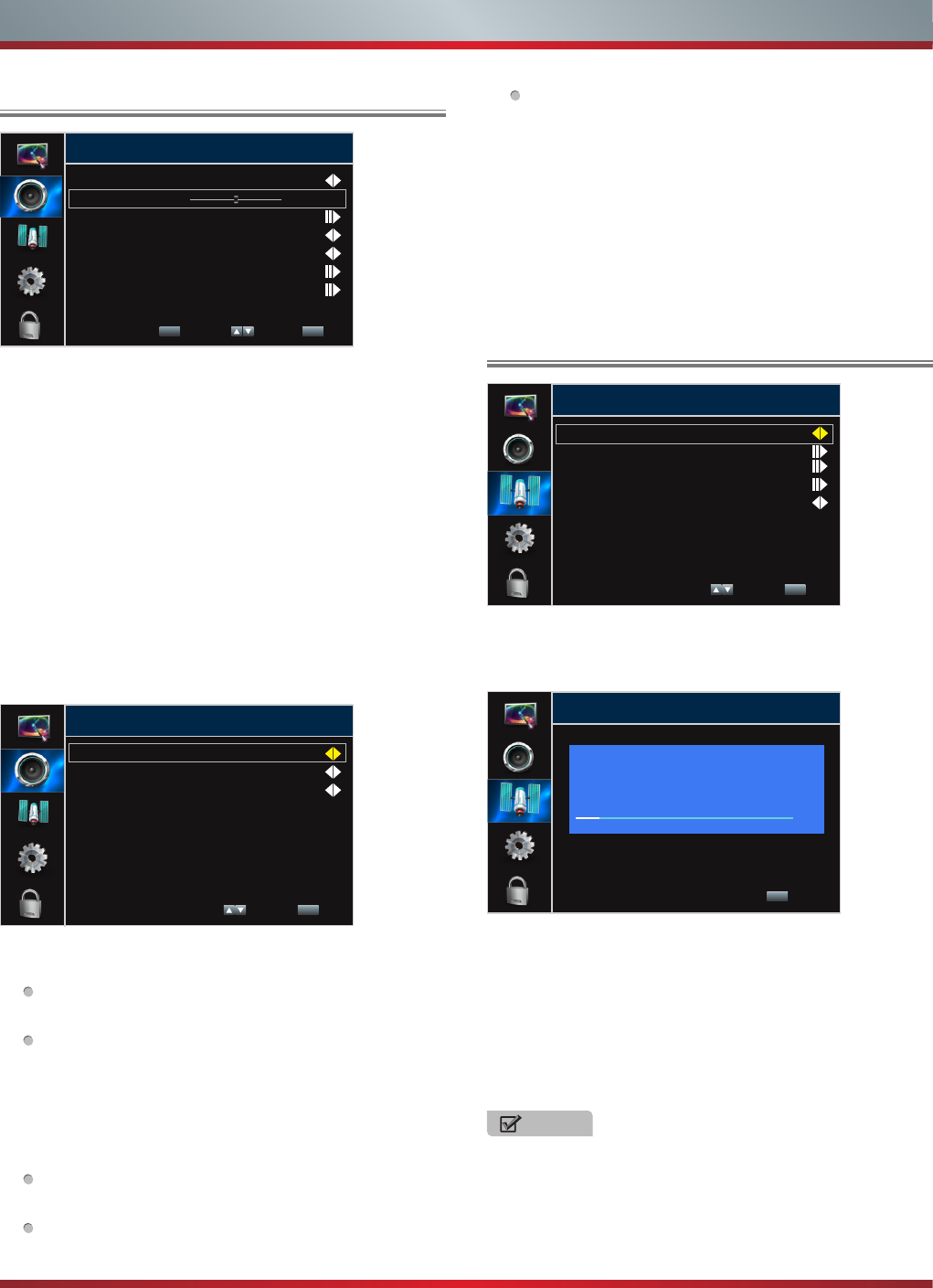
10
Basic Features
You can adjust:
Tuner Mode - Select the TV signal source. You can select
Antenna or Cable.
Channel Scan - Scans for channels that have signals and
stores the channels information in memory.
Digital Channels: The scanned TV program in digital
signals.
Analog Channels: The scanned TV program in analog
signals.
Channel Skip - You can cancel a channel stored in memory.
Using the TV Menu
Tuner Mode
Channel Scan
Channel Skip
Favorite List
Audio Only
Cable
Off
TV
Select MENU Back
Channel Scan
EXIT Cannel
Status: Scanning... Antenna
Analog Channels: 0
Digital Channels: 1
1%
Using the Audio Menu
You can adjust:
Sound Mode - Select the Sound Mode: Standard, Theater,
News, Music or Custom.
Balance - Adjust the volume of the left and right speakers.
Equalizer - Soften or enhance the sound at specific
frequency points.
Speaker - Selects where to play TV audio. You can select
On (default setting) to play audio through TV speakers, or
select Off to play audio through the speakers on an external
audio system.
Auto Volume Control - Automatically adjusts volume to a
consistent level; attenuates loud passages.
Advanced Audio - Access Advanced Audio settings such as
SPDIF Type, MTS, Audio Language.
SPDIF Type: Send digital audio to an external audio
system. You can select PCM, RAW or Off.
PCM: PCM outputs two channel audio regardless of
the input format.
RAW: When the data stream carries Dolby signal,
digital SPDIF outputs Dolby data stream. When the
data stream carries no Dolby signal, it transports PCM
data stream.
MTS: Select the default audio stream, you can select
Mono, Stereo or SAP (Second Audio Program).
MONO: Select this option if there is noise or static on
weak stereo broadcasts.
STEREO: Select this option for programs broadcast in
stereo.
Sound Mode
Balance
Equalizer
Speaker
Auto Volume Control
Advanced Audio
Reset Audio Settings
0
Music
On
Off
Audio
ENTER Adjust Select MENU Back
SPDIF Type
MTS
Audio Language
PCM
Stereo
English
Advanced Audio
Select MENU Back
SAP: Depending on the particular program being
broadcast, you can listen to a foreign-language
translation.
Audio Language - Change the default value for audio
language. (Digital channels only)
Reset Audio Settings - Resets all Audio Settings to the
factory defaults.
NOTE
When you press [CH
V
/V] (or [CH +/-]) button, your TV
skips the channel you cancelled. You can still tune to the
channel using the number buttons on the remote control.
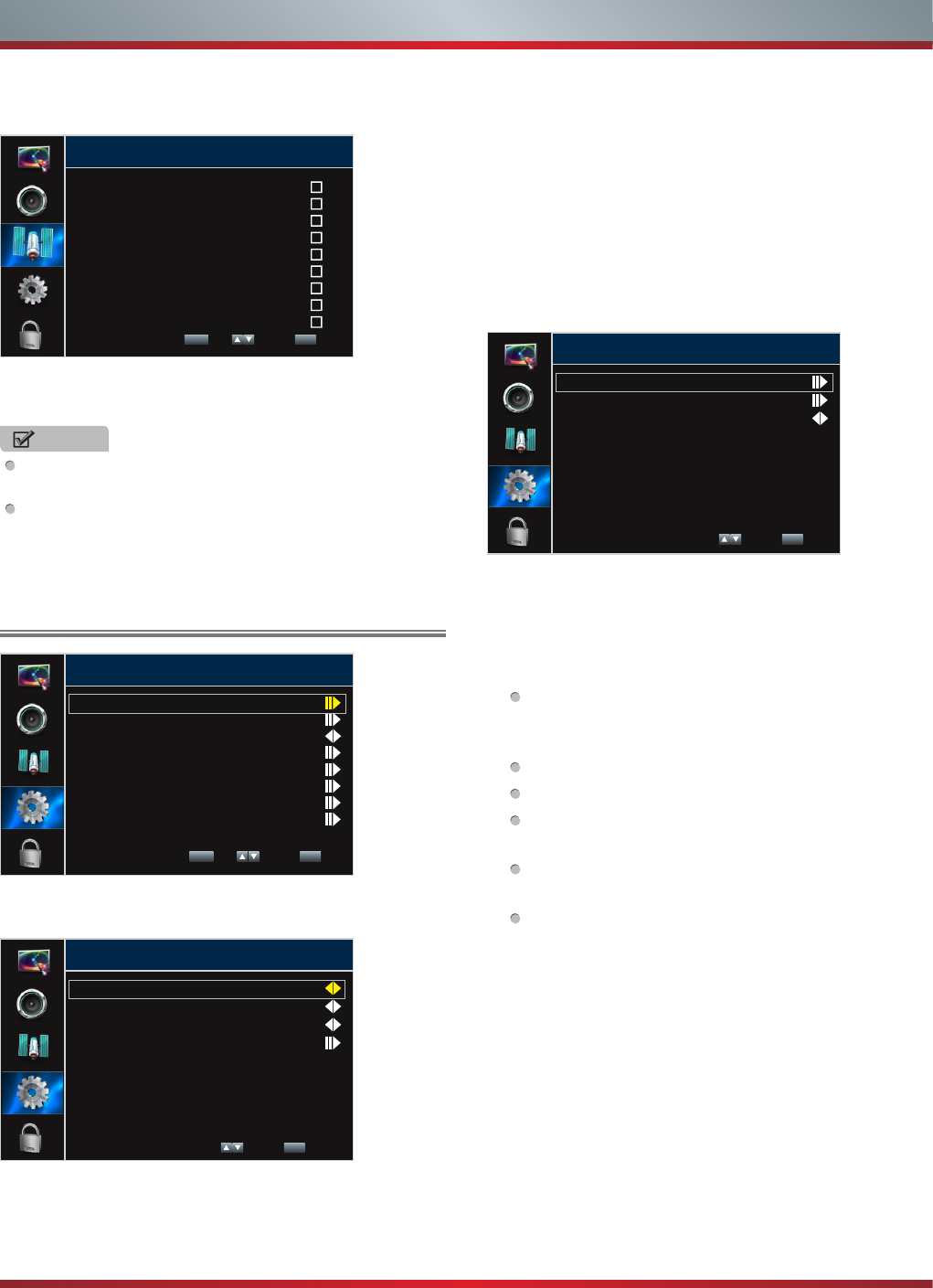
11
Using the Setup Menu
Basic Features
NOTES
Audio Only works only when the input source is TV, and
your TV is receiving a broadcast signal.
To exit audio only mode, press any button. When you exit
audio only mode, the Audio Only option is automatically
reset to Off.
Favorite List - Display your Favorite List. You can add or
delete channels to create your favorite list.
Audio Only - Listen to the program audio only, when you
turn off the picture on your TV.
You can adjust:
Closed Caption - Adjust Closed Caption settings.
CC Mode: To select CC Off (turns off closed caption), CC
On (turns on closed caption), or CC on when Mute (turns
on closed caption when the sound is muted).
CC Mode
Analog Closed Caption
Digital Closed Caption
Digital Caption Style
CC Off
CC1
Service1
Closed Caption
Select MENU Back
Analog Closed Caption: Select an Analog Caption
setting from CC1~CC4, TEXT1~TEXT4.
Digital Closed Caption: Select a Digital Caption setting:
Service1~Service6.
Digital Caption Style: There are two Caption Styles.
One is the automatic function set as the broadcaster,
while the other is the custom style where you can adjust
the font size, color, opacity, background color etc..
Time - Access Time settings such as Time Zone, Date/Time,
Sleep Timer.
Time Zone: Select your local time zone: Eastern Time,
Hawaii, Alaska, Arizona, Indiana, Mountain Time, Central
Time or Pacific Time.
Date/Time: You can set time manually or select automatic
if the TV is connected to an antenna or cable source.
Auto Synchronization: Select “On” to for automatic
date and time setting using information from broadcast
stations in your area.
Date: Set the current year/month/day.
Time: Set the current time.
Timer: When “On”, you can set the time when the TV
turns on/off automatically.
Power On Timer: Set the desired time for the TV to
turn on automatically.
Power Off Timer: Set the desired time for the TV to
turn off automatically.
Sleep Timer: Specify the amount of time before your TV
automatically turns off.
Menu Language - You can select the menu’s language to
English, Spanish or French.
HDMI-CEC - HDMI-CEC lets you control HDMI CEC-
compatible devices connected to the HDMI jacks on your
TV using the remote control that came with your TV. To use
HDMI-CEC, you must set the HDMI-CEC Control setting on
the Settings-HDMI-CEC menu to On.
Closed Caption
Time
Menu Language
HDMI-CEC
Computer Settings
Component Settings
Version Info
Reset Default
English
Setup
ENTER Set Select MENU Back
Time Zone
Date/Time
Sleep Timer Off
Time
Select MENU Back
Favorite List
Analog
Analog
Analog
Analog
Analog
Analog
Analog
Analog
Analog
1
2
3
4
5
6
7
8
9
ENTER Set Select MENU Back
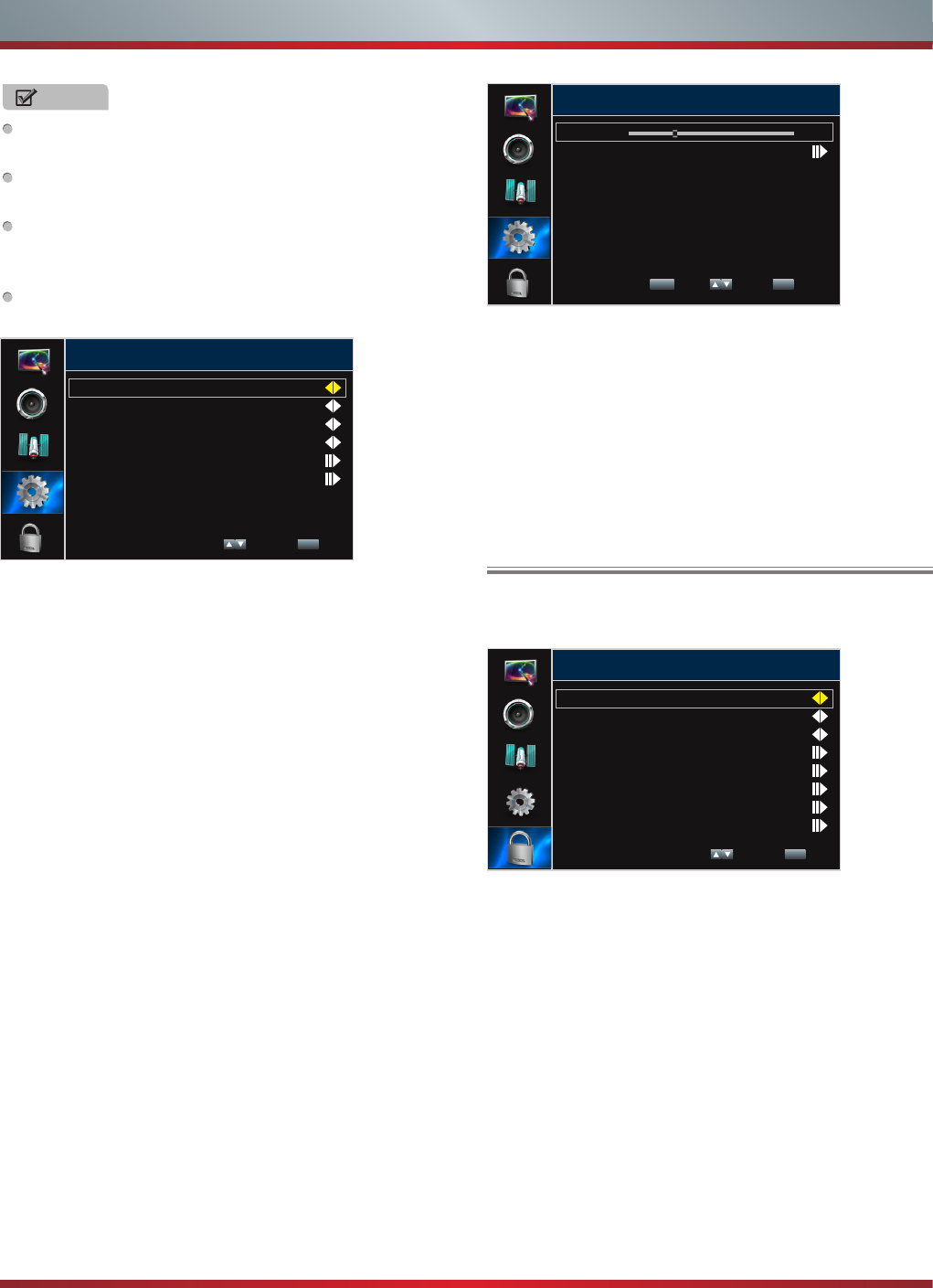
12
Using the Parental Menu
When you first use this function, the default password is
[0000]. Once you input this password, you can set options.
You can adjust:
Button Lock - Block or unblock the button of Keypad.
Rating Enable - Block or unblock TV ratings.
Block Unrated - Block unrated TV programs.
U.S. TV Ratings - Restrict TV programs by USA Ratings.
Open V-Chip: Display an advanced V-Chip ratings table
for digital channels (USA only).
Block Unrated: Block unrated TV programs.
U.S. Movie Ratings - Restrict movie by USA Ratings.
Canadian English/French Ratings - Restrict movie and TV
programs by Canadian Ratings.
Change Password - If you want to change the default
password, first enter the new password then enter the same
password again.
Basic Features
Button Lock
Rating Enable
Block Unrated
U.S. TV Ratings
U.S. Movie Ratings
Canadian English Ratings
Canadian French Ratings
Change Password
Off
Off
Off
Parental
Select MENU Back
NOTES
HDMI cables must be used to connect HDMI CEC-
compatible devices to your TV.
The connected device’s HDMI CEC feature must be
turned on.
If you connect an HDMI device that is not HDMI CEC-
compatible, all the HDMI-CEC Control features do not
work.
Depending on the connected HDMI device, the HDMI-
CEC Control feature may not work.
HDMI-CEC Control: Turning HDMI-CEC function on or
off.
Device Auto Power Off: When HDMI-CEC is turned on,
Device Auto Power Off turns off HDMI CEC devices when
you turn off your TV.
TV Auto Power On: When HDMI-CEC is turned on and
you turn on an HDMI CEC device, TV Auto Power On
turns on your TV automatically.
Audio Receiver: When HDMI-CEC is turned on and you
have connected an audio receiver to your TV, turning on
Audio Receiver lets you use your TV’s remote control to
control the volume on the audio receiver.
Root Menu: You can open an HDMI-CEC-compatible
device’s root menu, then use your TV’s remote control to
control the device.
HDMI-CEC Device Lists: You can display a list of HDMI
CEC devices that are connected to your TV.
Computer Settings (Only available in VGA mode.)-
Access Computer Settings such as H.Position, V.Position,
Phase, Clock and Auto Adjust.
H.Position: Move the image right or left.
V.Position: Move the image up or down.
Phase: Adjust the focus of stable images.
Clock: Adjust the sample frequency.
Auto Adjust: Detects input signal clock, phase and
position and adjusts TV display accordingly.
Component Settings (Only available in Component
mode.) - Access Component Settings such as phase, Reset
Component Settings.
HDMI-CEC Control
Device Auto Power Off
TV Auto Power On
Audio Receiver
Root Menu
HDMI-CEC Device Lists
On
Off
Off
Off
HDMI-CEC
Select MENU Back
Phase: Adjust the focus of stable images.
Reset Component Settings: This function can help you
restore the component settings.
Version Info - Display the software version information.
Reset Default - Every TV has its original setting before
leaving the factory. This function can help you restore these
settings.
Phase
Reset Component Settings
12
Component Settings
ENTER Adjust Select MENU Back
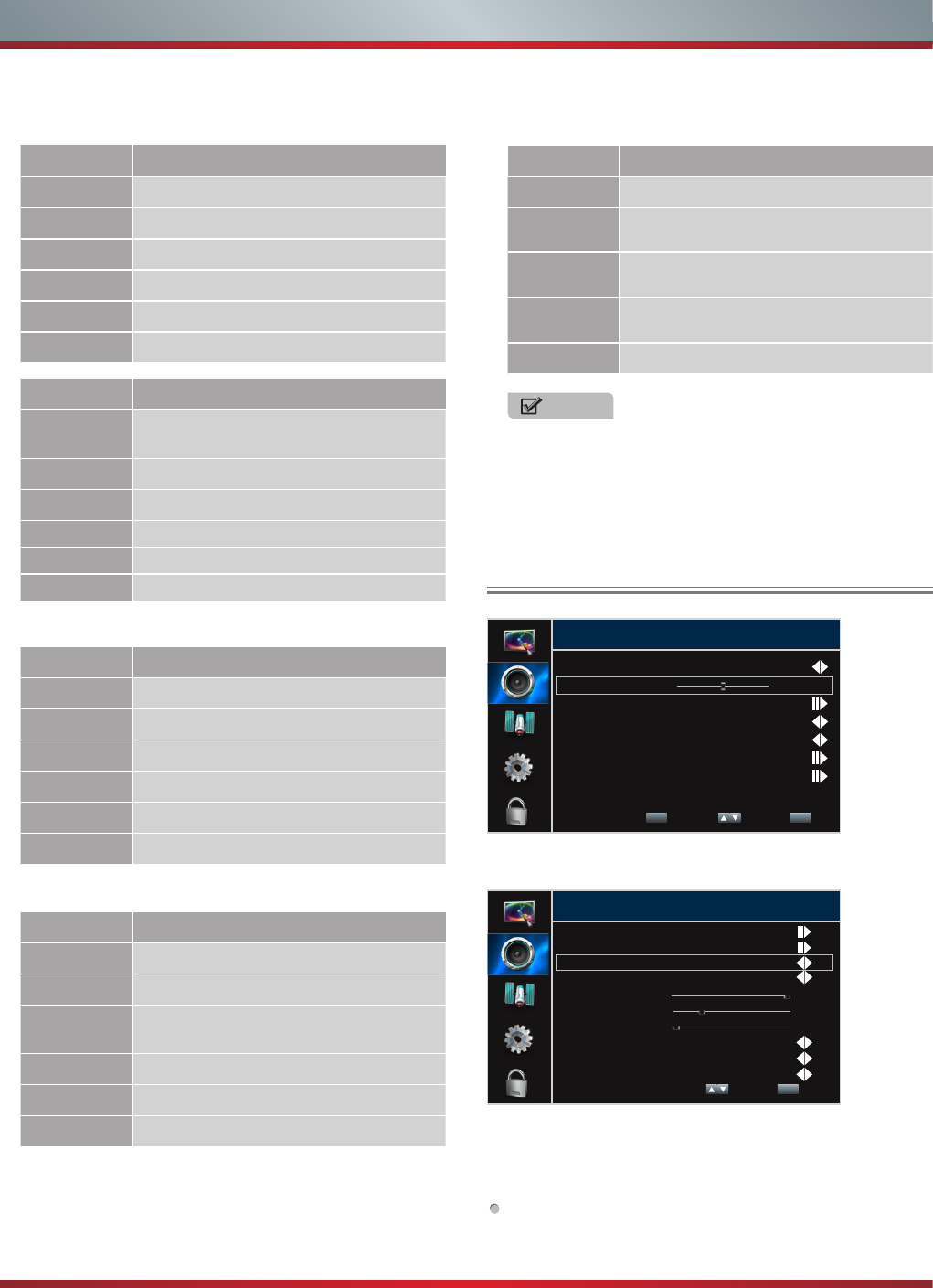
13
Basic Features
Canadian French Ratings
Rating Description
G General
8 ans+ 8+General; Not recommended for young
children
13 ans+ Programming may not be suitable for
children under the age of 13
16 ans+ Programming is not be suitable for
children under the age of 16
18 ans+ Programming restricted to adults
Canadian English Ratings
Rating Description
C Children
C8+ Children 8 years and older
GGeneral Programming, suitable for all
audiences
PG Parents Guidance
14+ Viewers 14 years and older
18+ Adult Programming
NOTE
As you block rating, all rating higher than the ones you
select are blocked as well. E.g. if you choose to block
the MPAA rating R, the higher ratings, NC-17 and X,
are automatically blocked too.
Following is the description of these ratings.
U.S. TV Ratings
Age Defined as
TV-Y All children
TV-Y7 Directed to older children
TV-G General audience
TV-PG Parental Guidance suggested
TV-14 Parents Strongly cautioned
TV-MA Mature Audience only
Contents Defined as
AAll of the ratings below that rating set
blocked automatically
D Suggestive dialogue
L Strong language
S Sexual situations
V Violence
FV Fantasy Violence
U.S. Movie Ratings
Rating Defined as
G General audience
PG Parental Guidance suggested
PG-13 Parents strongly cautioned
R Restricted
NC-17 No one 17 and under admitted
X Adult audience only
Using the Hotel Menu
Follow”MENU”>”AUDIO”>”BALANCE”(setting is 0)”, Input
“548“ by remote control to open hotel menu.
You can adjust:
Restore - Clone the TV channel setting from the USB flash
driver to this TV.
Turn a new TV on and insert the USB flash driver( with
"HOTEL.bin" file in) to USB port.
Sound Mode
Balance
Equalizer
Speaker
Auto Volume Control
Advanced Audio
Reset Audio Settings
0
Music
On
Off
Audio
ENTER Adjust Select MENU Back
Restore
Clone
Hotel mode
KB lock
Max volume
On volume
Min volume
On channel
Tuner Mode
On source
100
20
0
Hotel Menu
Select MENU Back
On
Off
2
Antenna
Last
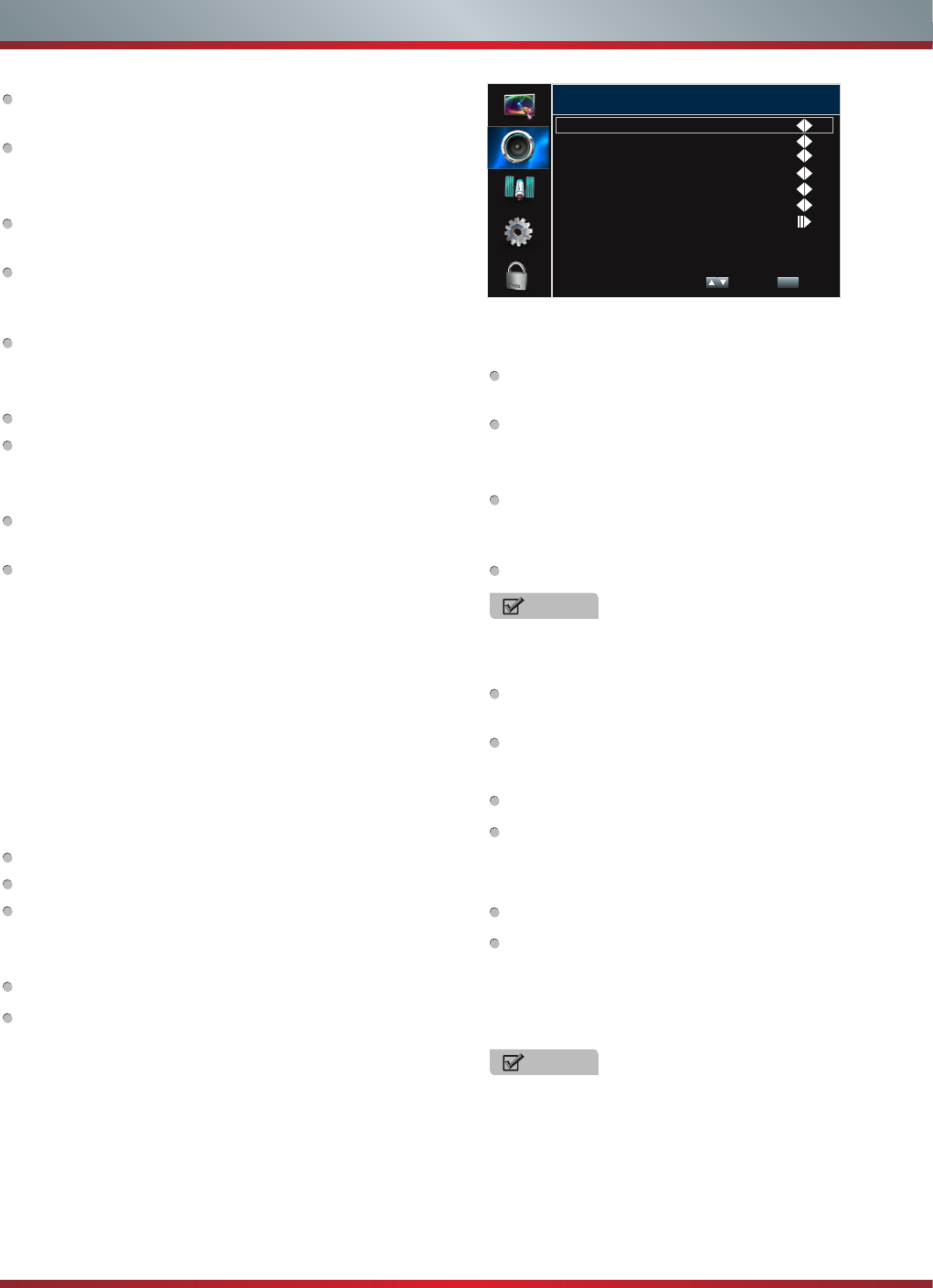
14
Use UP/DOWN arrow button to highlight "Restore" and
press ENTER button to restore the channel setting.
Remove USB flash driver. Turn the TV off and Turn it on
again to check the setting.
Clone - Clone the TV channel setting to USB flash driver.
Turn the TV on and insert the USB flash driver to USB
port.
Use UP/DOWN arrow button to highlight "Clone" and
press ENTER button to clone. Hotel menu will exit
automatically when finish clone the channel setting.
Remove USB flash driver and check it. There will be a
"HOTEL.bin" file in the USB flash driver.
Hotel Mode - Enable or disable the setting in hotel menu.
Set to "ON": The following HOTEL functions can be used.
Set to "OFF": Hotel Mode is switched off. The following
HOTEL functions cannot be used.
KB Lock - TV keyboard lock setting.
Select "ON", TV keyboard button doesn't work when
customer press it.
Select "OFF", TV keyboard works as normal TV when
customer press it.
Max Volume - Control the max volume that can be adjusted
by customer. Setting range is from 0 to 100.
On Volume - Force the default volume when turn the TV on.
Setting range is from 0 to 100(less than or equal to the max
volume)
Min Volume - Control the Min volume that can be adjusted
by customer. Setting range is from 0 to 100(less than or
equal to the On volume)
On Channel - Force the default channel in TV source when
turn the TV on.
Setting range is from 1 to 135 in cable model.
Setting range is from 2 to 69 in Antenna model.
LAST means TV will show the last watch channel when
turn TV on again.
Tuner Mode - Select cable or antenna in the TV source.
Select Cable to enable cable model.
Select Antenna to enable antenna model.
On Source - Force the input source when turn the TV on.
Setting range includes all input sources and LAST.
LAST means TV will show the last watch source when turn
TV on again.
User Save Lock - Control to restore the customer setting or
default setting when turn on the TV.
Select "ON" to restore the default setting when turn on
the TV.
Select "OFF" to restore the customer setting when turn
on the TV.
Basic Setting - Enable or disable standard mode setting.
Select "ON" to force video mode, audio mode to "Vivid"
mode and Zoom to "Wide" mode. And disable User Save
Lock function.
Select "OFF" to disable the function.
NOTE
"Basic setting" is prior than "Use save lock" function.
Auto Standby - TV Power management.
Select "ON" to turn TV off after 15 minutes if there is no
input signal.
Select "OFF" to turn TV on all the time.
Search Lock - Enable or disable channel scan function.
Select "ON" to enable channel scan function.
Select "OFF" to disable channel scan function
Submenu Lock - Enable or disable advance setting in
picture menu.
Select "ON" to disable advance setting in picture menu.
Select "OFF" to enable advance setting in picture menu.
Logo Option - Select type of Logo when turn TV on.
Range includes "Default Logo", "No Logo", "Welcome" and
"Hisense".
NOTE
All changes take effect after restart TV.
User Save Lock
Basic setting
Auto Standby
Search Lock
Submenu_Lock
Logo Option
Source Lock
Hotel Menu
Select MENU Back
Off
Off
Off
Off
Off
Off
Default logo
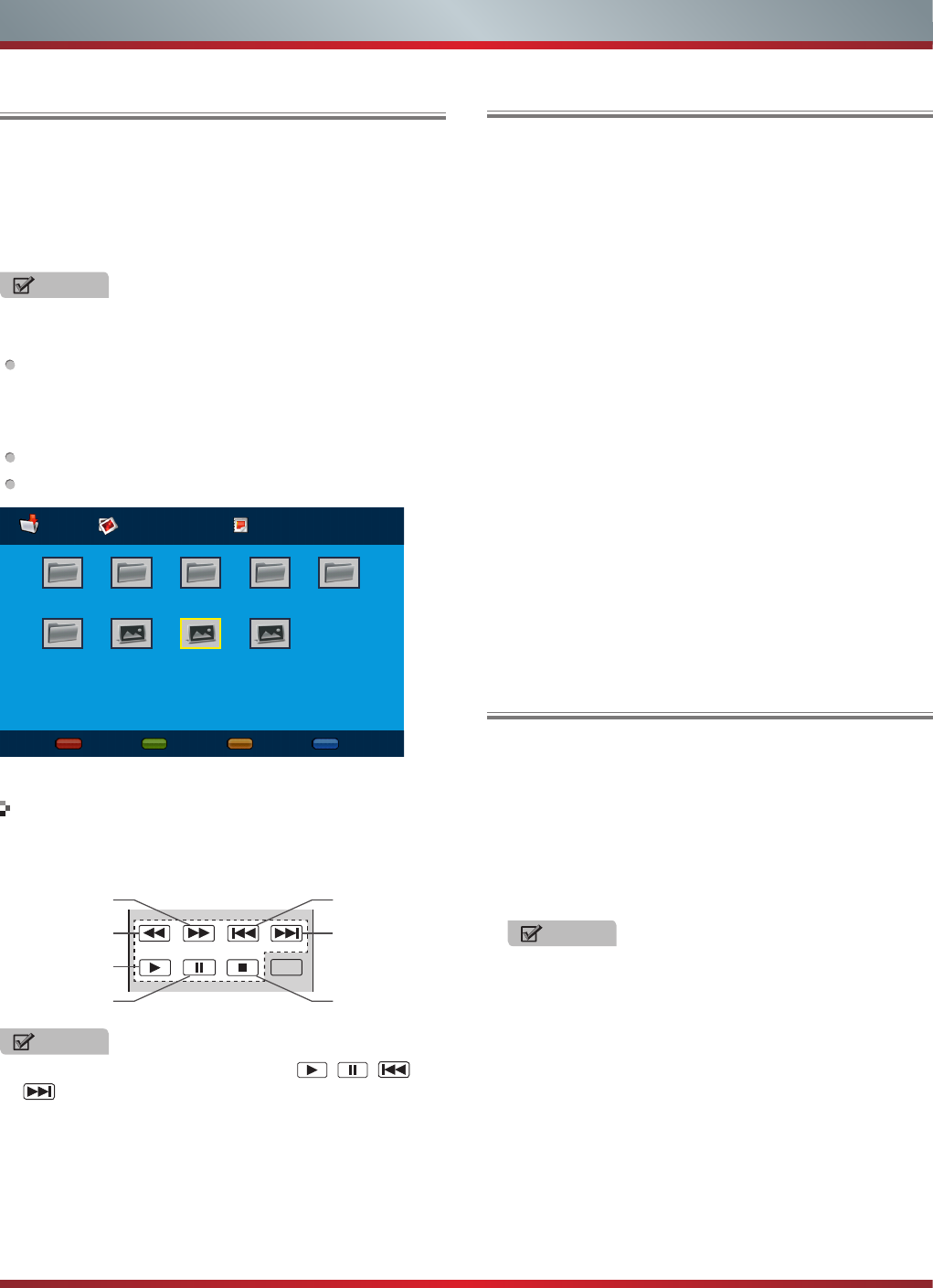
15
Digital Media Player
Advanced Features
Please note that Hisense will not assume any responsibility
for any lost data and cannot guarantee perfect compatibility
with all mass storage devices. Be sure to insert the USB disk
with standard USB 2.0 port. Data Input from USB Memory
Stick only. Do not connect any device to this terminal such
as digital camera, keyboard, mouse, etc.
Press [INPUT] button to display the INPUT menu, press
[▲/▼] button to highlight the USB source, then press
[ENTER] button to confirm. (If you want to exit DMP, you
can press [INPUT] button to switch to other sources).
Press [RED] button to switch the media type.
Press [CH
V
/V] button to turn to the previous/next page.
When viewing video/photo, you can press these buttons on
the remote control to control video/photo.
Media content control function buttons
NOTE
Never remove the USB flash drive or turn off your TV
while viewing video/photo.
NOTE
When browsing the photos, only the , , and
buttons are available.
Enjoy Video Files
Browse the Photos
1. Press [RED] button to switch the media type to Video.
2. Press [▲/
▲
/
▲
/
▲
] to select the video you want to view.
3. Press [ENTER] to play the video.
4. Press [EXIT] to exit the video and return to the previous
directory.
5. When enjoying the video, press [MENU] button to display/
exit the menu. Press [
▲
/ENTER] to enter the submenu
and press [
▲
/EXIT] to return to the upper menu.
Play/Pause: You can play/pause the video.
Repeat: Adjust the loop mode of video.
Show Info: View the video information.
Picture Mode: Select the picture mode from Vivid,
Standard, Theater, Energy Savings and Custom.
Screen Mode: Select the screen aspect ratio from
Normal, Zoom, Wide, Cinema and Auto.
Audio Mode: Select the audio mode from Standard,
Theater, News, Music and Custom.
6. You can press [MTS/SAP] button one or more times to
select the sound track. Press [ASPECT] button one or
more times to enlarge the image by 1X, 2X, 4X and 8X.
1. Press [RED] button to switch the media type to Photo.
2. Press [▲/
▲
/
▲
/
▲
] to select the photo you want to view.
3. Press [ENTER] to browse the photo.
4. Press [EXIT] to return to the previous directory.
5. When browsing photos, press [MENU] button to display /
exit the menu. Press [
▲
/ENTER] to enter the submenu
and press [
▲
/EXIT] to return to the upper menu.
Play/Pause: You can browse/pause the photo.
Repeat: Repeats the slide show when it reaches the end.
Shufe: Displays the slide show photo in random order.
Duration: Allows you to browse the photo at different
speed. You can also press [GREEN] button to select it.
Effect: Set how the photo appears on the screen. You
can also press [YELLOW] button to select it.
Rotate: Allows the photo to rotate 90 degrees.
Show Info: View the photo information.
GUIDE
Fast forward
Play
Pause
Fast backward
The previous
one
The next one
Stop
NOTE
When the photos in browsing or pausing, the menu will
be different.
Media Type
01/01050680 Photo
Folder
Folder
Folder Folder Folder Folder
JPEG 050680 JPEG
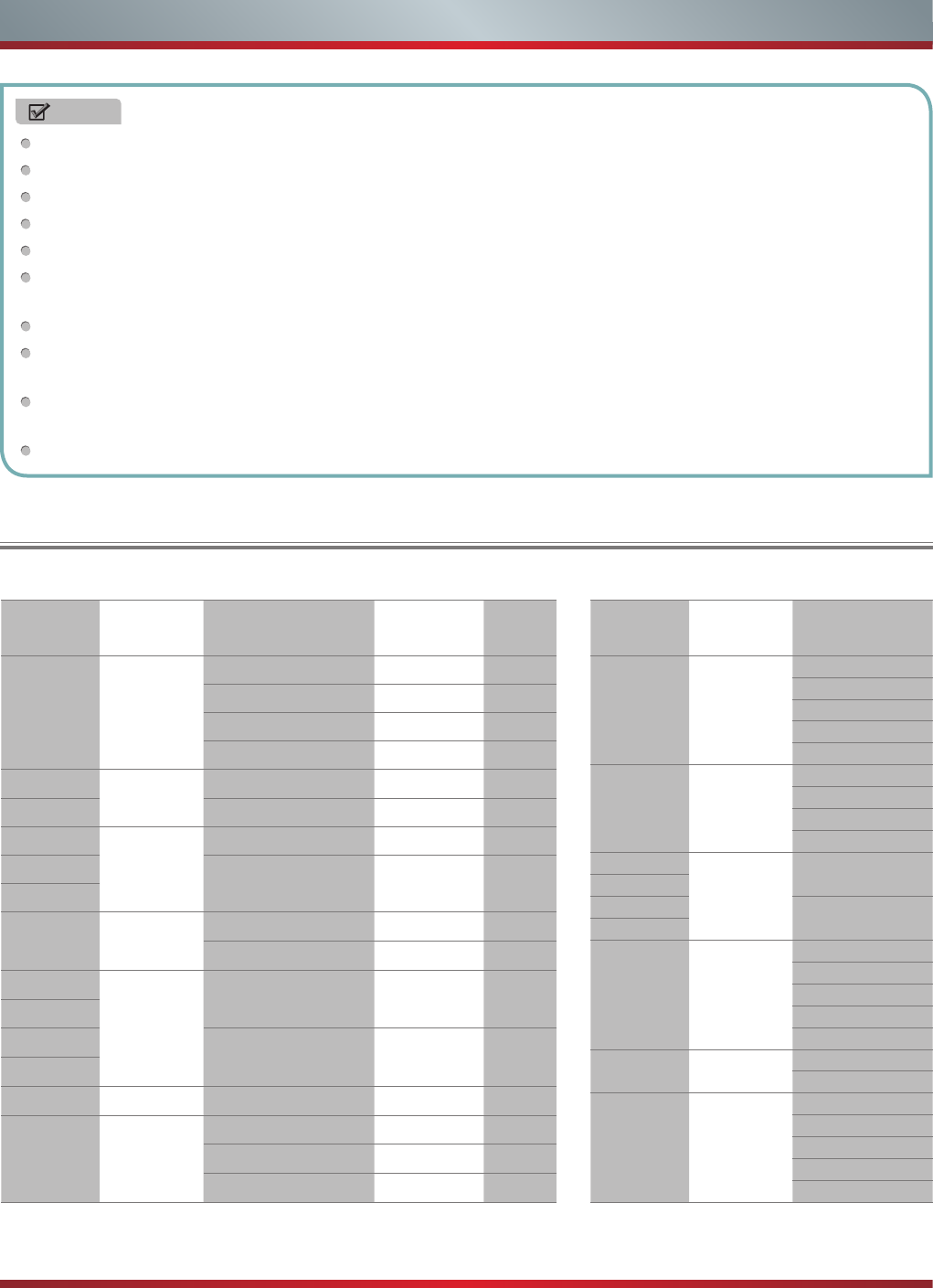
16
Advanced Features
Playable Format List
File
extension Container Video Decoder Resolution Bitrate
(bps)
*.avi AVI
MPEG1 768*576 1.8M
MPEG2 MP@HL 1920*1080 40M
MPEG-4 SP@HL 3.0 1920*1080 40M
MPEG-4 ASP@HL 4.0 1920*1080 40M
*.wmv
ASF
MPEG-4 SP@HL 3.0 1920*1080 40M
*.asf MPEG-4 ASP@HL 4.0 1920*1080 40M
*.mp4
MP4
MPEG-4 SP@HL 3.0 1920*1080 40M
*.mov
MPEG-4 ASP@HL 4.0 1920*1080 40M
*.3gp
*.mkv MKV
MPEG-4 SP@HL 3.0 1920*1080 40M
MPEG-4 ASP@HL 4.0 1920*1080 40M
*.mpg
PS
MPEG1 768*576 1.8M
*.mpeg
*.vro
MPEG2 MP@HL 1920*1080 40M
*.vob
*.ts TS MPEG2 MP@HL 1920*1080 40M
*.ogm OGG
MPEG2 MP@HL 1920*1080 40M
MPEG-4 SP@HL 3.0 1920*1080 40M
MPEG-4 ASP@HL 4.0 1920*1080 40M
Video Decoder Support List Audio Decoder Support List
File
extension Container Audio
Decoder
*.avi AVI
MPEG1 Layer1/2
MPEG2 AAC
MPEG4 AAC-LC
MPEG4 HE-AAC
AC3
*.MP4 MP4
MPEG1 Layer1/2
MPEG2 AAC
MPEG4 AAC-LC
MPEG4 HE-AAC
*.mpg
PS
MPEG1 Layer1/2
*.mpeg
*.vro AC3
*.vob
*.ts TS
MPEG1 Layer1/2
MPEG2 AAC
MPEG4 AAC-LC
MPEG4 HE-AAC
AC3
*.rm RM MP3
MPEG2 AAC
*.mkv MKV
MPEG1 Layer1/2
MPEG2 AAC
MPEG4 AAC-LC
MPEG4 HE-AAC
AC3
The unit recognizes only a USB Memory Stick.
Do not use a USB hub or an extension cable to connect an external hard disk drive to the unit. (Not supported)
A USB Memory Stick is always inserted to this unit directly.
A USB Memory Stick is not supplied with this unit.
We do not guarantee that all USB Memory Sticks can be supported by this unit.
Be sure to keep a backup copy of the original files on your device before you play them back on this unit. We have no
responsibilities for damage or loss of your stored data.
To protect your USB Memory Stick files from being erased place the write protect sliding tab in the protect position.
When you are ready to remove a USB Memory Stick, set the unit to go into Standby mode to avoid any damage to your
data and the unit.
A USB Memory Stick that requires its own driver or the device with a special system such as fingerprint recognition are
not supported.
This unit is not allowed to use the USB Memory Stick which requires an external power supply (500mA or more).
NOTES
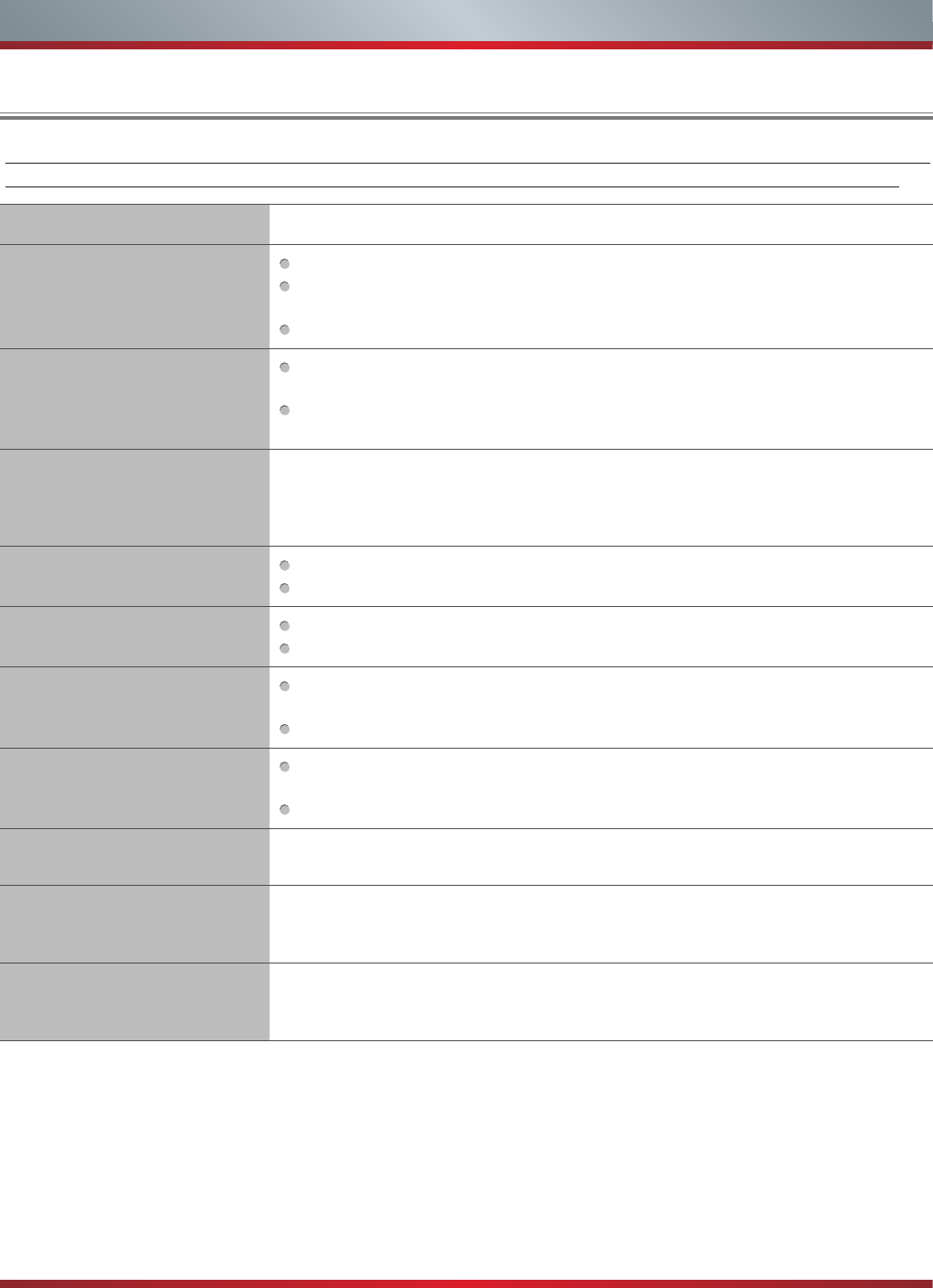
17
Other Information
When there is something wrong with your TV, you can try turning off the TV and then restart it. You can also Operate
according to the following chart. If the problem still cannot be solved, please contact the professional technicians.
SYMPTOMS POSSIBLE SOLUTIONS
No sound or picture.
Check if the power cord is in the AC outlet and if it has electricity.
Check if you have pressed [POWER] button on the TV or [POWER] button on the
remote control.
Check to see if LED light is either red or blue. If illuminated, power to TV is OK.
I have connected an external
source to my TV and I get no
picture and/or sound.
Check for the correct output connection on the external source and for the correct
input connection on the TV.
Make sure you have made the correct selection for the input mode for the incoming
signal.
When I turn on my television,
there is a few second delay
before the picture appears. Is
this normal?
Yes, this is normal. That is the TV searching for previous setting information and
initializing the TV.
Picture is normal, but no sound. Check the volume settings.
Check if Mute mode is set “on”.
Sound but no picture or black
and white picture.
If black and white picture first unplug TV from AC outlet and replug after 60 seconds.
Check Color Setting if picture is black and white.
Sound and picture distorted or
appear wavy.
An electrical appliance may be affecting TV set. Turn off any appliances, if
interference goes away, move appliance farther away from TV.
Insert the power plug of the TV set into another power outlet.
Sound and picture is blurry or
cuts out momentarily.
If using an external antenna, check the direction, position and connection of the
antenna.
Adjust the direction of your antenna or reset or fine tune the channel.
Horizontal/vertical stripe on
picture or picture is shaking. Check if there is interfering source nearby, such as appliance or electric tool.
The plastic cabinet makes a
“clicking” type of sound.
“Click” sound can be caused when the room temperature changes. This change
causes the television cabinet to inflate or contract, which makes the sound. This is
normal and TV is OK.
Black square appears in the
center of my television screen?
The Closed Caption function is set in the text mode. To remove it, access Closed
Caption from the menu screen and change the Mode setting from text to either CC1 or
off .
Trouble Shooting
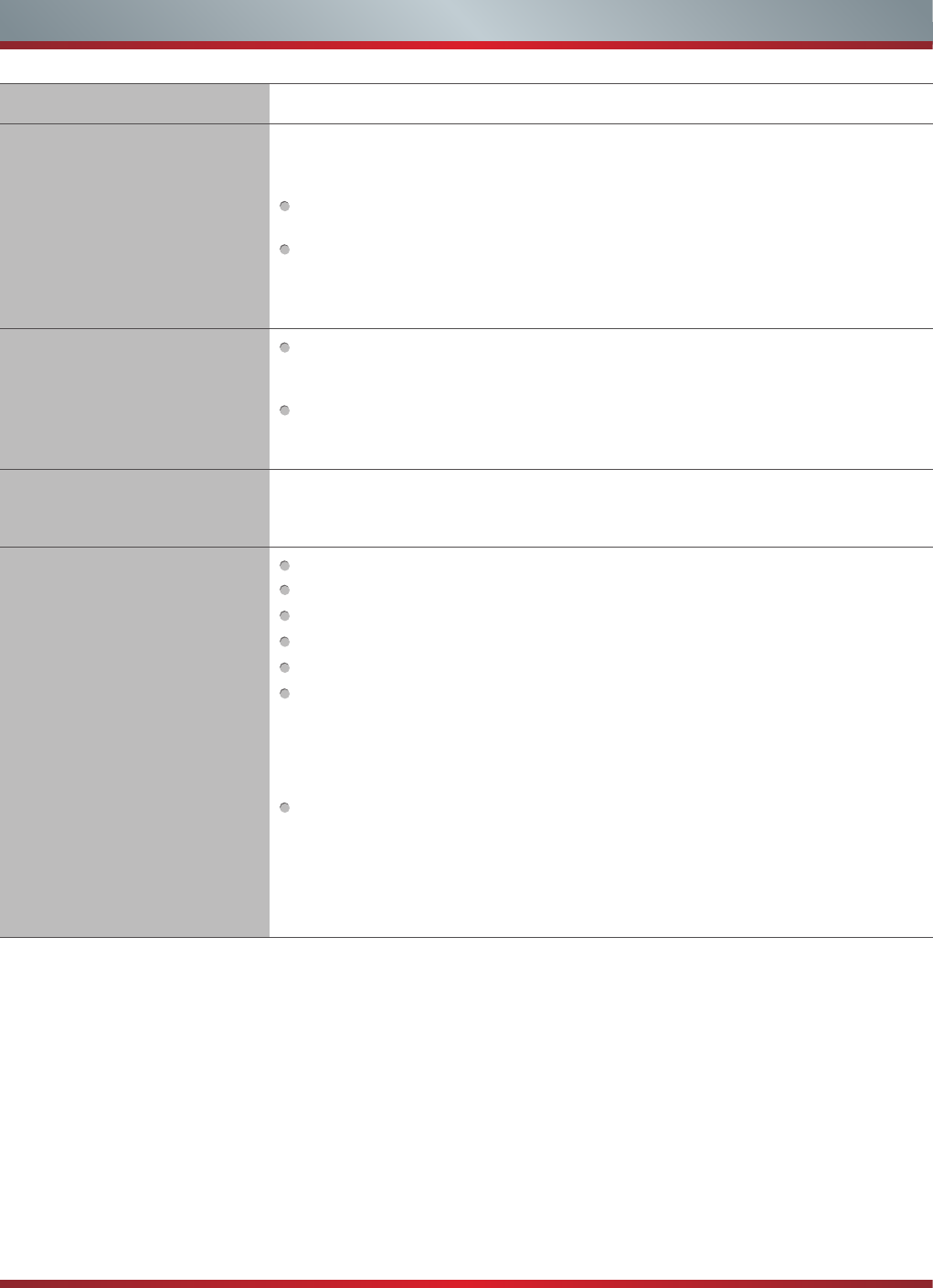
18
SYMPTOMS POSSIBLE SOLUTIONS
On some channels getting
another language or sometimes
no sound at all.
That would indicate that the MTS mode on your unit is set to SAP mode. We suggest
setting the MTS mode to either Stereo or Mono . For further instruction, please see
Audio Adjust or MTS/SAP in your user manual.
SAP is Second Audio Program. It’s a second audio channel that is usually used for a
second language or descriptive audio for the visually impaired.
MTS stands for Multichannel Television Sound, a standard that allows the encoding
of 3 channels of audio within a standard NTSC (analog) video signal to a television.
A television that is able to receive MTS Stereo allows you to watch television with
stereo sound.
Not getting all of my cable
channels on the television or I’m
only getting 13 channels.
Check the cable connection for an incoming signal. Make sure the signal is coming
OK. Best way to confirm signal is to use another TV and/or contact your cable
company.
Reprogram your channels. Press [MENU] button on your TV remote control, change
Input Source setting to “Cable”, then use “Auto Channels Search” to reprogram your
channels.
[CH
V
/ V] don’t work when I
set the Channel to Cable? They
work with the Air setting?
After switching to Cable, please auto program the channels. The TV will “remember” all
the channels then the TV will allow you to surf the channels with [CH
V
/V] buttons.
Remote control does not work.
Confirm that TV still has power and is operational.
Change the batteries in the remote control.
Check if the batteries are correctly installed.
Clean the front of the remote control (LED window).
If using a universal remote, be sure to select the TV mode on the remote.
If the remote still does not work:
• Remove and reinstall the batteries correctly to reset the remote or install new
batteries.
• Press the Power button to turn on the TV. With a universal remote if you have reset
or changed the batteries you will need to reprogram the remote for the other units.
Check if there is obstruction between the remote control and the TV.
TIP: If you have a digital camera / camera phone, you can aim the front of the remote
at camera lenses (at this time, the camera should set on camera mode, not play
mode). Observe the camera screen while pressing a button on the remote control; you
should see flashing light on the screen. If there is no light observed, the remote control
is not working. You need to repair or replace the remote control.
Other Information
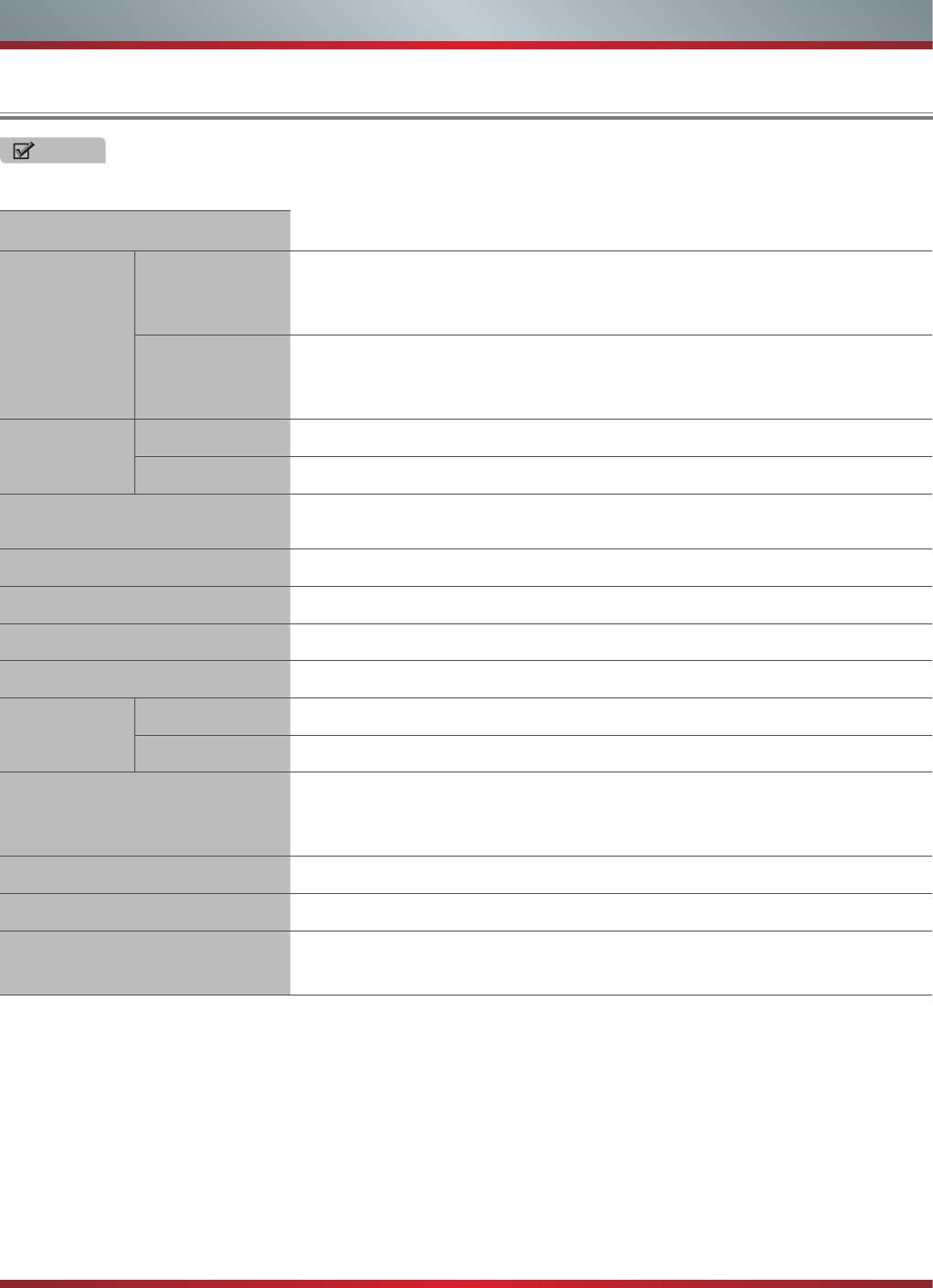
19
NOTE
Features, appearance and specifications are subject to change without notice.
Model Name LHD32K20DHUS
Dimension
Without Stand
Width: 28.9 inches (735.3 mm)
Height: 17.4 inches (441.9mm)
Depth: 3.0 inches (76 mm)
With Stand
Width: 28.9 inches (735.3 mm)
Height: 19.6 inches (497.6 mm)
Depth: 7.9 inches (200 mm)
Weight
Without Stand 13.2 lbs (6 kg)
With Stand 14.3 lbs (6.5 kg)
LCD Panel Minimum size
(diagonal) 31.5 inches
Screen resolution 1366 × 768
Audio power 6 W + 6 W
Power consumption Please refer to the rating label.
Power supply 120 V ~ 60 Hz
Receiving
systems
Analog NTSC
Digital ATSC / QAM
Environmental conditions
Temperature: 41°F ~ 95°F (5°C~ 35°C)
Humidity: 20%-80% RH
Atmospheric pressure: 86 kPa - 106 kPa
Component Input 480 I / 60 Hz, 480 P / 60 Hz, 720 P / 60 Hz, 1080 I / 60 Hz
VGA Input VGA (640×480 / 60 Hz), SVGA (800×600 / 60 Hz), XGA (1024×768 / 60 Hz)
HDMI Input RGB / 60 Hz (640×480, 800×600, 1024×768)
YUV / 60 Hz (480 I, 480 P, 720 P, 1080 I)
Other Information
Specifications